
Recruitment Automation in 2025: The Complete Guide

Is your recruitment agency operating at peak efficiency? If you’re still relying on outdated manual processes, the answer is likely no. It’s time to explore the transformative power of recruitment automation.
To win in today’s talent market, speed is paramount. Recruitment automation provides the necessary velocity to outpace competitors and place top-tier candidates first.
More placements, less stress, and happier clients. Recruitment automation is the key to achieving these goals. Let’s explore how to integrate this smart tech into your agency’s operations and drive sustainable growth.
What is Recruitment Automation?
Recruitment automation is about getting technology to do all the repetitive tasks in the recruiting process.
Automated workflows are a key component of recruitment automation. You can set up automatic workflows for stuff that usually drives you nuts.
Candidate sourcing? Check. Outreach? You got it. Interview scheduling? Done. Skill assessments? Yup. At the end of the day, it’s cutting out all the manual tasks.
Here are some common examples:
- Use AI candidate matching systems to find the perfect candidate instantly.
- Engage candidates via chatbots that answer FAQs or schedule interviews.
- Predict candidate success by analyzing past hiring data.
- Auto-post jobs across 50+ boards with a single click.
One major use case and an ideal example is to automatically send personalized emails or SMS to candidates based on certain events or triggers, such as a candidate receiving an email or a text message right after they apply.
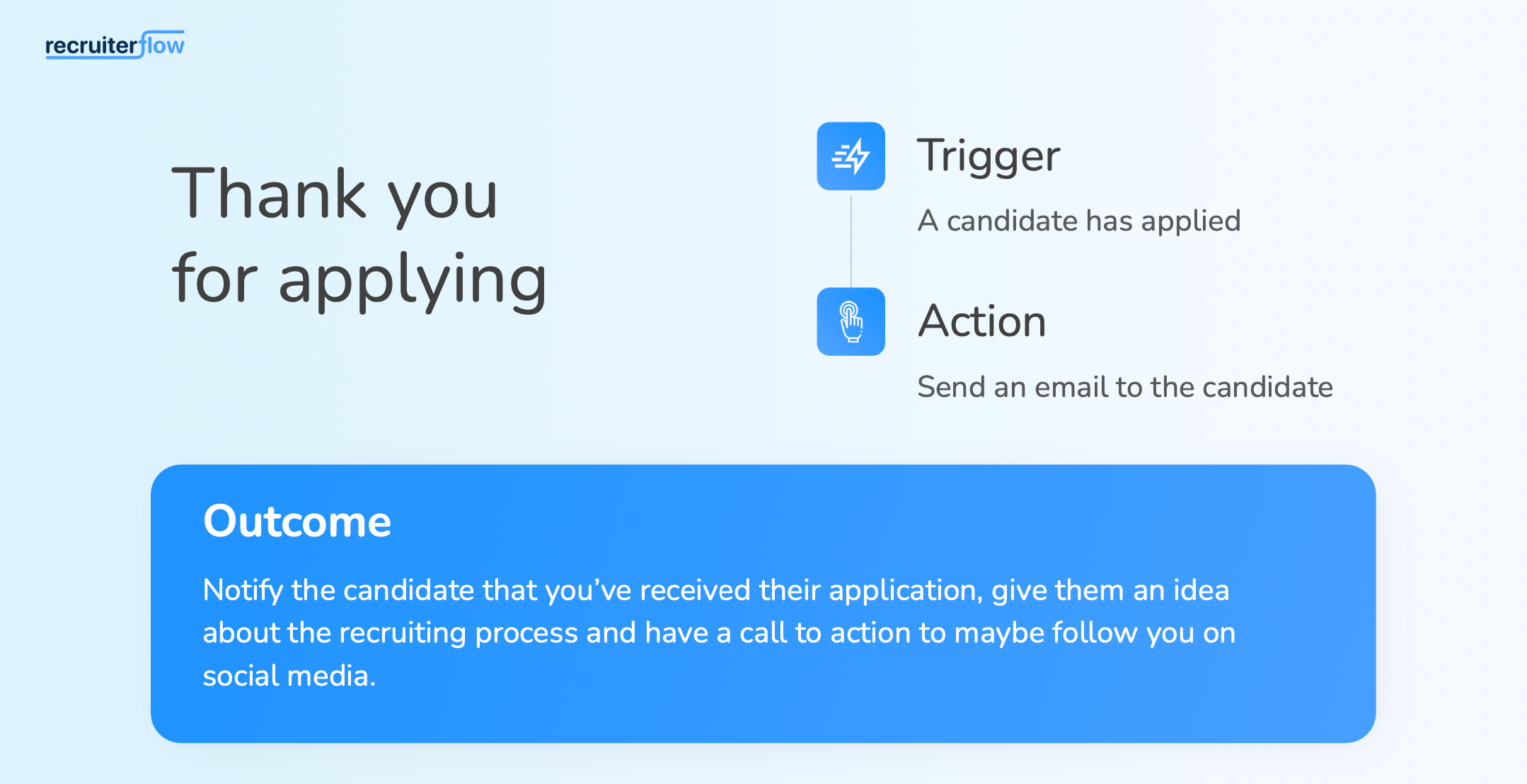
2025’s automation? It’s next level. We’re not just talking basic stuff. These tools learn from your choices. They adapt to your agency’s unique processes. And they can even spot bias in job descriptions.
How Recruitment Automation Smooths the Hiring Process for Recruiting Agencies
Staffing agencies are leveling up their game with staffing automation in 2025. Automation is kicking those old, slow ways of doing things to the curb so recruiters can actually recruit. Let’s dive into the key benefits of automating the recruiting process.
Accelerated Hiring Timelines
ATS systems chop hiring cycles by 60%. And AI? That thing can slash time-to-hire by a whopping 70% in those crazy high-volume hiring scenarios.
One company even saw their hiring time drop by 75% after they jumped on the automation train, according to a Deloitte study. Isn’t that wild? IBM even says it lets recruiters focus on chatting up candidates instead of drowning in paperwork.
Enhanced Candidate Experience
Automated workflows make sure everyone’s on the same page, so candidates don’t bail. Candidates get real-time updates, through emails or messages that keep them in the loop.
When you’re upfront and honest, it makes them feel like they matter. And it works! 85% of candidates say they have better experiences with automated systems, according to a survey by TalentLyft.
Increased Recruiter Productivity
Over 80% of recruiters swear by automation for boosting their productivity.
Recruiters often spend 35% of their time just scheduling interviews. Automate that, and you’ve got hours back. Reports say you can free up 3 to 5 hours a day!
That’s time you can use to talk to people and get to know them. Sharlyn Lauby, an HR expert, says, “When you automate the right tasks, then it frees up time to do the in-person ones better.”
Improved Quality of Hire
62% of teams using ATS say they’re hiring better people. Unilever even uses AI to analyze video interviews, and their hiring managers are 50% happier with the candidates.
Also, want to find the best of the best? Automation helps you sift through a ton of candidates super quick. AI filters out the irrelevant and leaves you with the real stars.
Cost Efficiency and Scalability
Who doesn’t love saving money? Automating things like resume screening and job postings can save you up to 30% per hire. That’s huge, especially in those high-turnover industries.
Plus, if you’re looking to grow without breaking the bank, automation’s your buddy. You can handle more work without hiring a ton more people.
Also, check out our blog on the best recruiting apps.
How to Implement Recruitment Automation in 2025
Let’s look at the 7 best ways to implement recruiting automation in 2025:
1. Invest in an ATS for Efficient Hiring
Not using an Applicant Tracking System (ATS) to automate your hiring process? You’re playing recruitment on hard mode. An ATS is how you automate chaos, slash administrative work, and focus on what matters the most.
Manual hiring processes cost you time, money, and talent. There are a ton of benefits to using an ATS:
- 75% of recruiters say ATS tools reduce time-to-hire by 30%+ (2024 Recruiter Efficiency Report).
- Companies using ATS cut hiring costs by $7,000 per role on average (SHRM 2025 Data).
- AI-powered ATS platforms (like Recruiterflow or Lever) can rank candidates 4x faster than humans (LinkedIn Talent Trends 2025).
An ATS automates repetitive tasks—posting jobs, sorting resumes, scheduling interviews—and acts as a centralized hub for all candidate data. Think of it as the “control center” for your hiring process.
Here are some of the key features of an ATS:
- Resume parsing automatically extracts skills, experience, training certificates and education from resumes.
- Automated workflows trigger actions (e.g., sending rejection emails) based on predefined rules.
- Collaboration tools let your team leave feedback, rate candidates, and track progress in real time.
- Analytics dashboards track metrics like time-to-hire, source of hire, and cost-per-hire.
So how do you choose the right ATS for your agency? Not all ATS platforms are created equal. Ask yourself:
- Does it integrate with your existing tools (e.g., LinkedIn, Calendly, or your CRM)?
- Is it user-friendly for both recruiters AND candidates?
- Can it scale as your agency grows?
Here are the top 3 ATS tools for agencies in 2025:
- Recruiterflow: Ideal for ambitious agency teams with its unified CRM + ATS.
- Greenhouse: Best for customization and data-driven hiring.
- Bullhorn: Perfect for high-volume, enterprise staffing agencies.
Recruiterflow’s ATS provides you with all the essential features you’d find in a typical ATS and more:
- A CRM to manage both your candidate and client relationships
- AI candidate matching and sourcing tools
- Recruiting automation to automate all your recruiting processes
- Automated multi-channel outreach (Email, SMS, Call & Socials)
- Advanced reporting and analytics tools
Get started with Recruiterflow’s ATS by setting up your hiring pipeline. It’s super easy to define your pipeline stages. Navigate to ‘Settings’ > ‘Job Settings’ to create and customize pipeline templates.
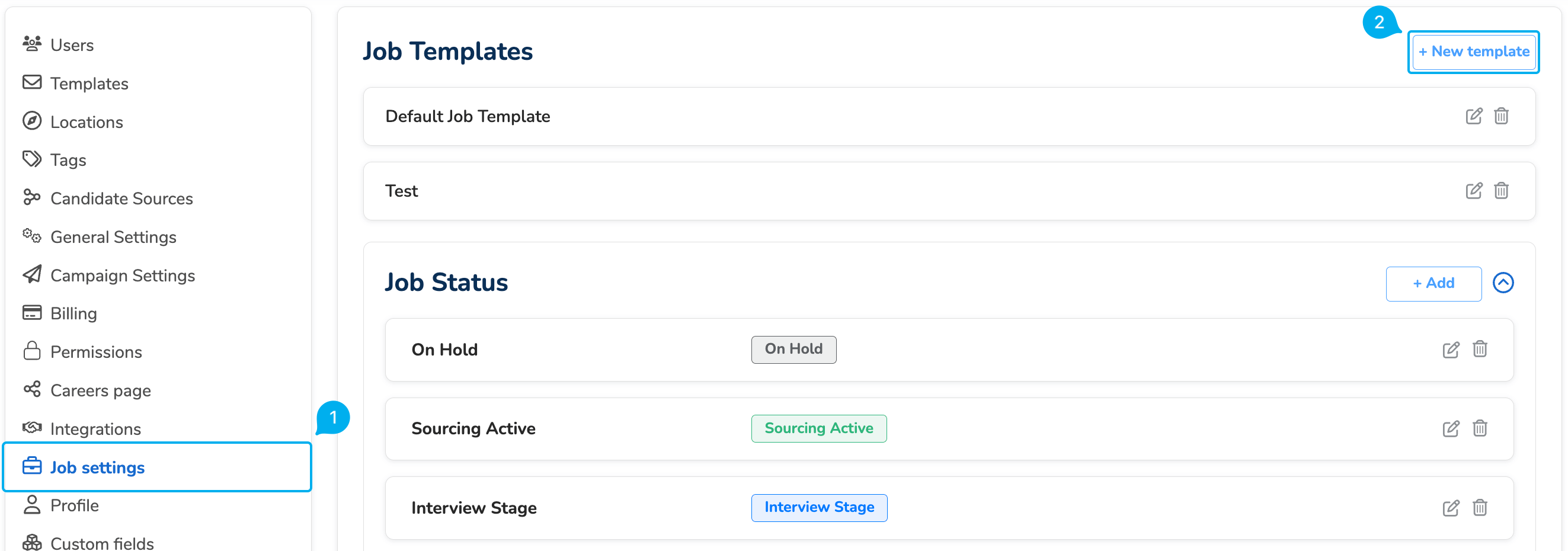
For example, establish stages such as “Recruiter Screen”, “Client Interview”, and “Offer Extended” based on your workflow.
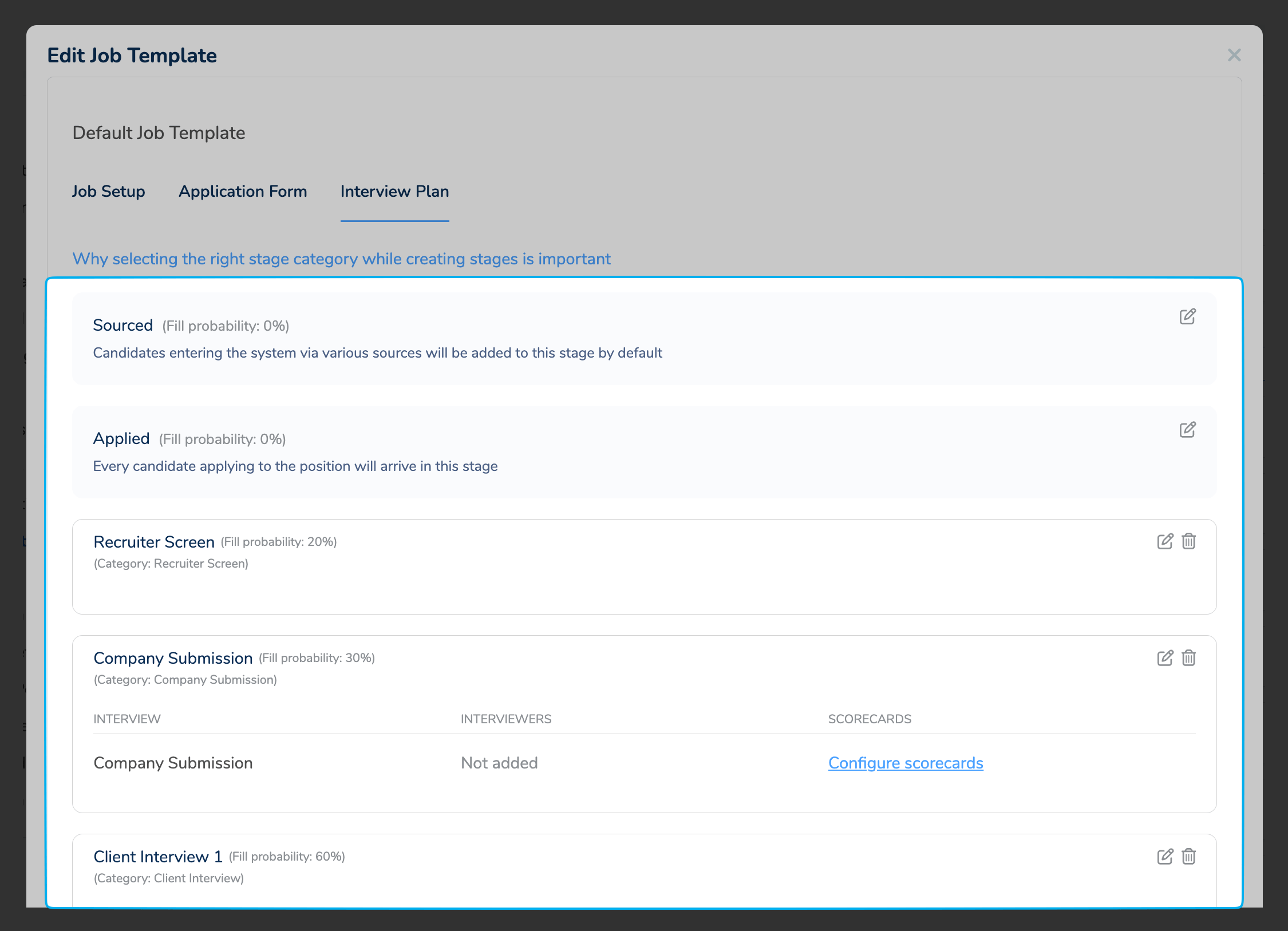
Use the drag-and-drop interface to organize stages visually. The Kanban view makes it easy to track candidates through different stages of the recruitment process. You can view all interactions, manage candidate statuses, and ensure that no candidate falls through the cracks.

BardWood, a leading recruitment firm in the UK, reduced time-to-hire by 50% after adopting Recruiterflow’s ATS. Their recruiters now spend 70% less time on administrative tasks and focus on strategic hiring.
You can also check out our comprehensive guide on candidate matching.
2. Automate Job Postings
Ever found yourself drowning in job boards, copying-pasting the same description across 10 platforms, only to realize you forgot to update the salary range on two of them?
Yeah, we’ve all been there. There are other headaches with job postings as well. Time wasted? Inconsistent branding? Let automation tackle it.
Get started with your ATS’s built-in job distribution features. Most Applicant Tracking Systems (ATS) like Recruiterflow, Lever, or Greenhouse let you blast job postings to multiple platforms with one click.
For example, Recruiterflow allows recruiters to post jobs simultaneously across 150+ job boards, such as Indeed, Glassdoor, ZipRecruiter, SimplyHired, LinkedIn, and Jooble. Recruiterflow also covers niche job boards like Dice (for Tech) or Reed (for UK).
Simply navigate to the ‘Promote’ section while creating a Job listing to select job boards. Make sure the job status is set correctly (e.g., external) so that it can be visible to potential applicants on the selected job boards.
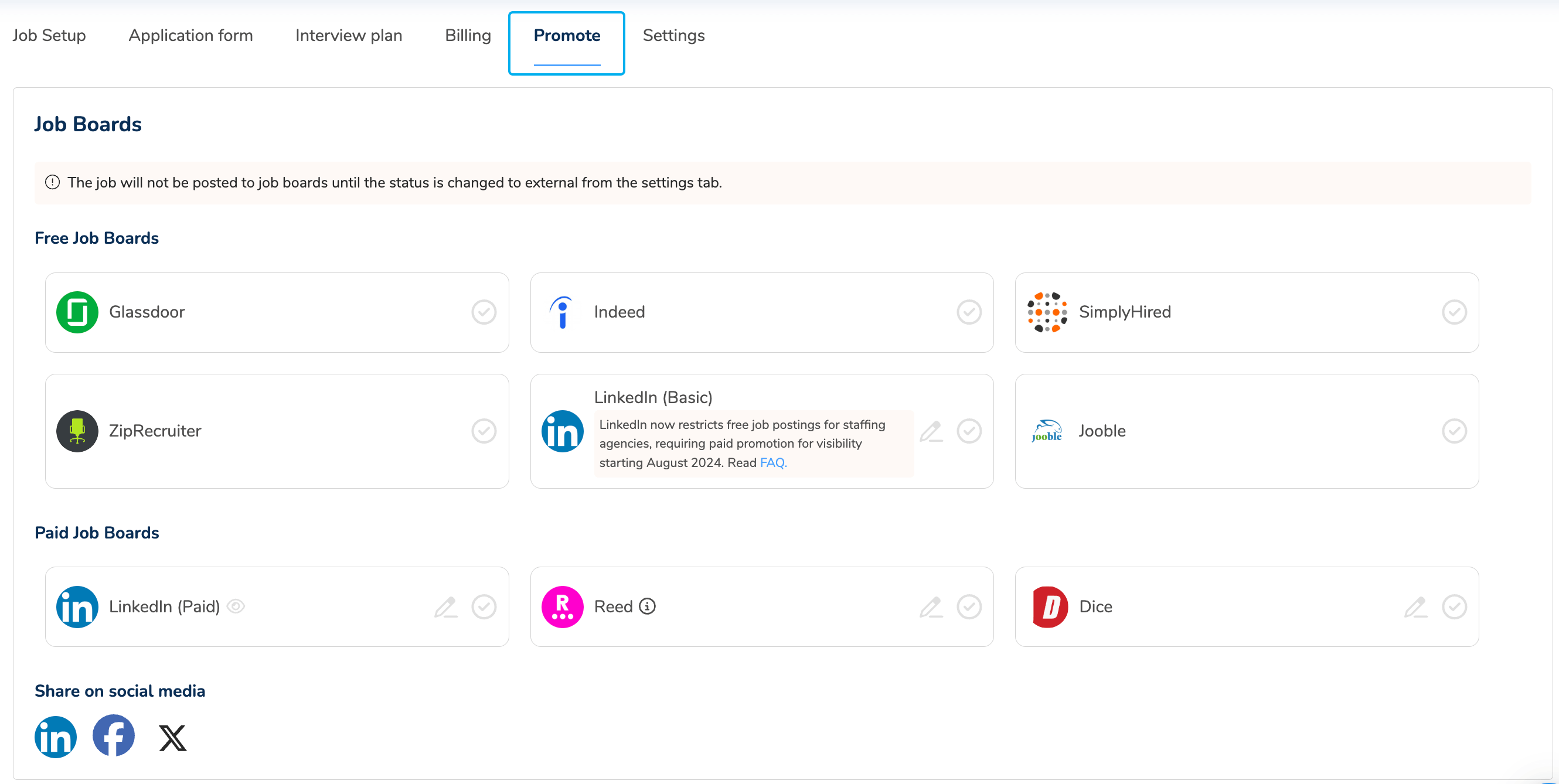
Take the help of AI to create effective job descriptions. Generic job descriptions attract generic candidates. Tools like Textio or Recruiterflow use AI to:
- Analyze language bias (e.g., reducing masculine-coded words like “competitive” to attract diverse applicants).
- Suggest keywords that rank higher on job boards.
Ask RF GPT, Recruiterflow’s AI recruiting assistant, to help you write compelling job descriptions from scratch or rewrite existing ones based on key job details such as skills, experience, education, etc.
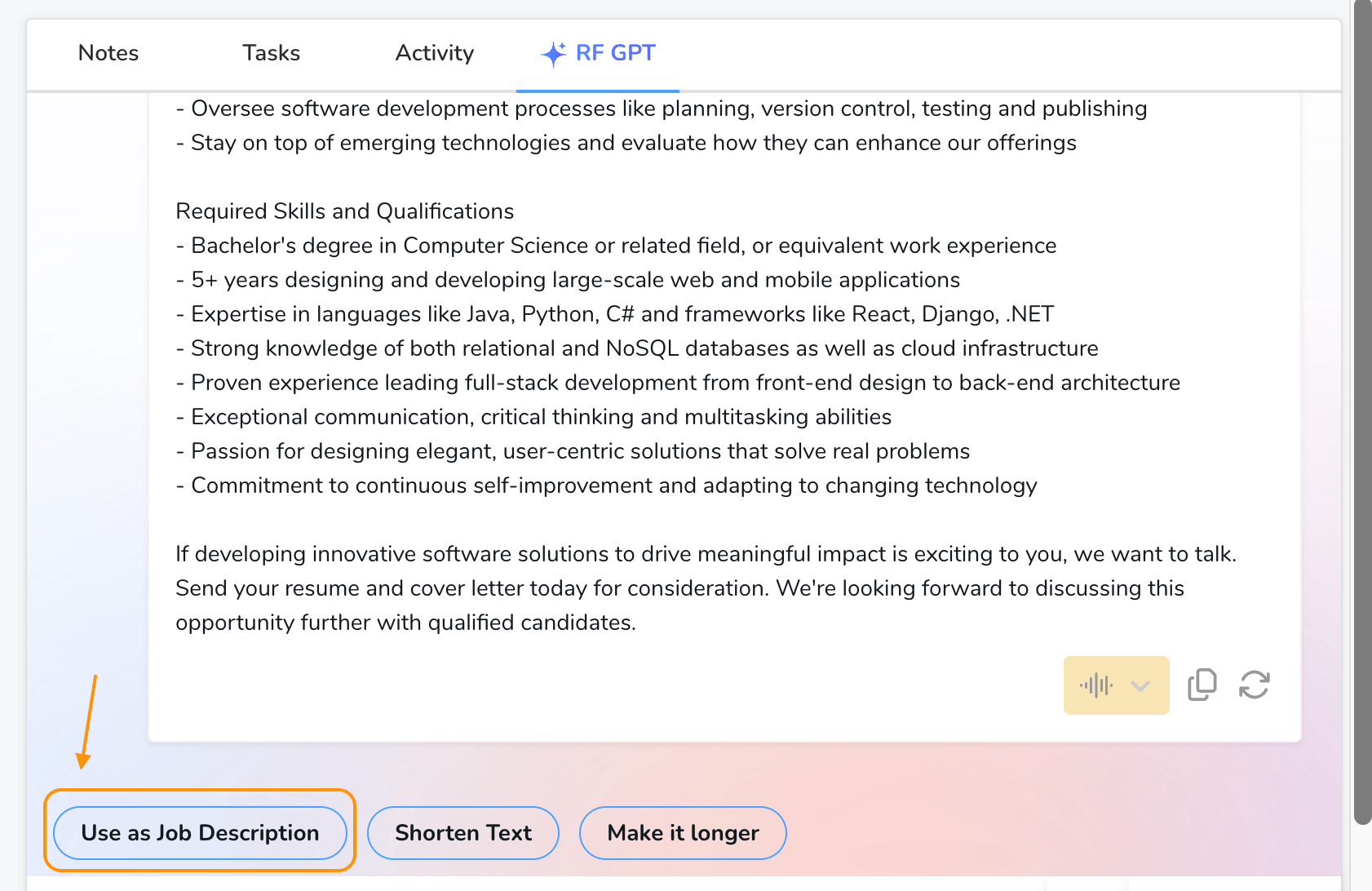
Pro Tip: Set up templates for recurring roles (e.g., “Sales Associate” or “Software Engineer”) to ensure consistency and avoid errors. Check out these sample job description templates for inspiration.
Automate posting analytics to optimize your ROI. Companies that A/B test job postings see a 50% faster hiring cycle (HR Tech Institute, 2023). Use tools like Recruiterflow Analytics to track:
- Which boards drive the most applicants (e.g., LinkedIn vs. Indeed)?
- Time-to-fill metrics to identify bottlenecks.
3. Streamline Candidate Screening with Automation
Manual screening is just tedious and inefficient. A 2024 LinkedIn report found recruiters spend 40% of their time reviewing resumes, yet 72% of hiring managers say they’ve missed great candidates due to human error. Automation fixes this:
- Eliminates bias: AI tools prioritize skills over demographics.
- Slashes time-to-screen: Cut screening time by up to 75% (Harvard Business Review).
- Improves accuracy: Algorithms spot keywords and patterns humans might miss.
Tech startup ScaleFlow reduced time-to-hire by 30% after automating resume screening with AI. Their secret? Letting bots flag candidates with Python and cloud computing skills so recruiters can focus on assessing cultural fit.
Modern recruitment platforms use AI to recommend candidates based on role requirements. Try Recruiterflow for AI-driven candidate matching.
Continuity Partners, a US-based tech staffing agency, reduced their time-to-placement by 25% and improved candidate quality through Recruiterflow’s AI-driven matching and screening capabilities.
Here’s how its AI candidate matching system works:
After creating a Job, open it, navigate to the ‘AI Matches’ card, and click ‘Generate’.
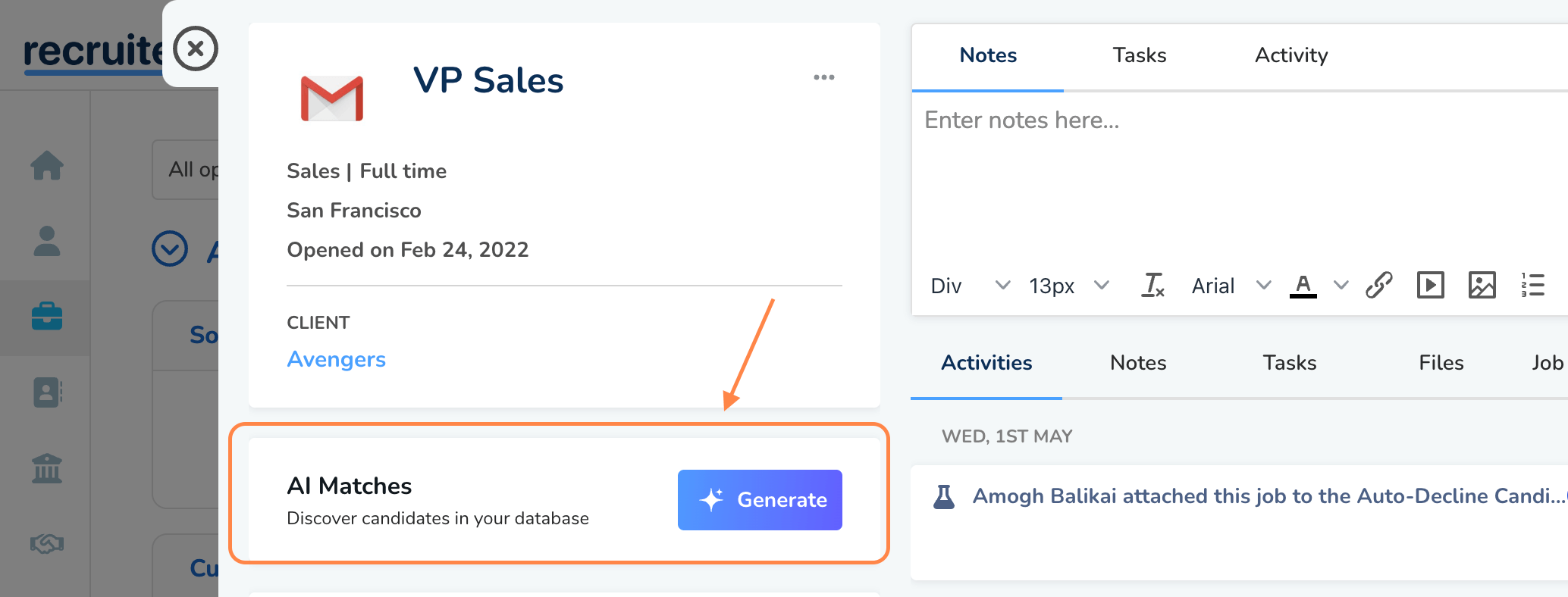
The AI then:
- Analyzes the job details
- Scans your agency’s candidate database
- Ranks candidates, from most to least relevant, based on relevance to the role
You can then further refine the list with advanced search filters like choosing an ‘Industry’ or entering a specific salary range to get the desired results.
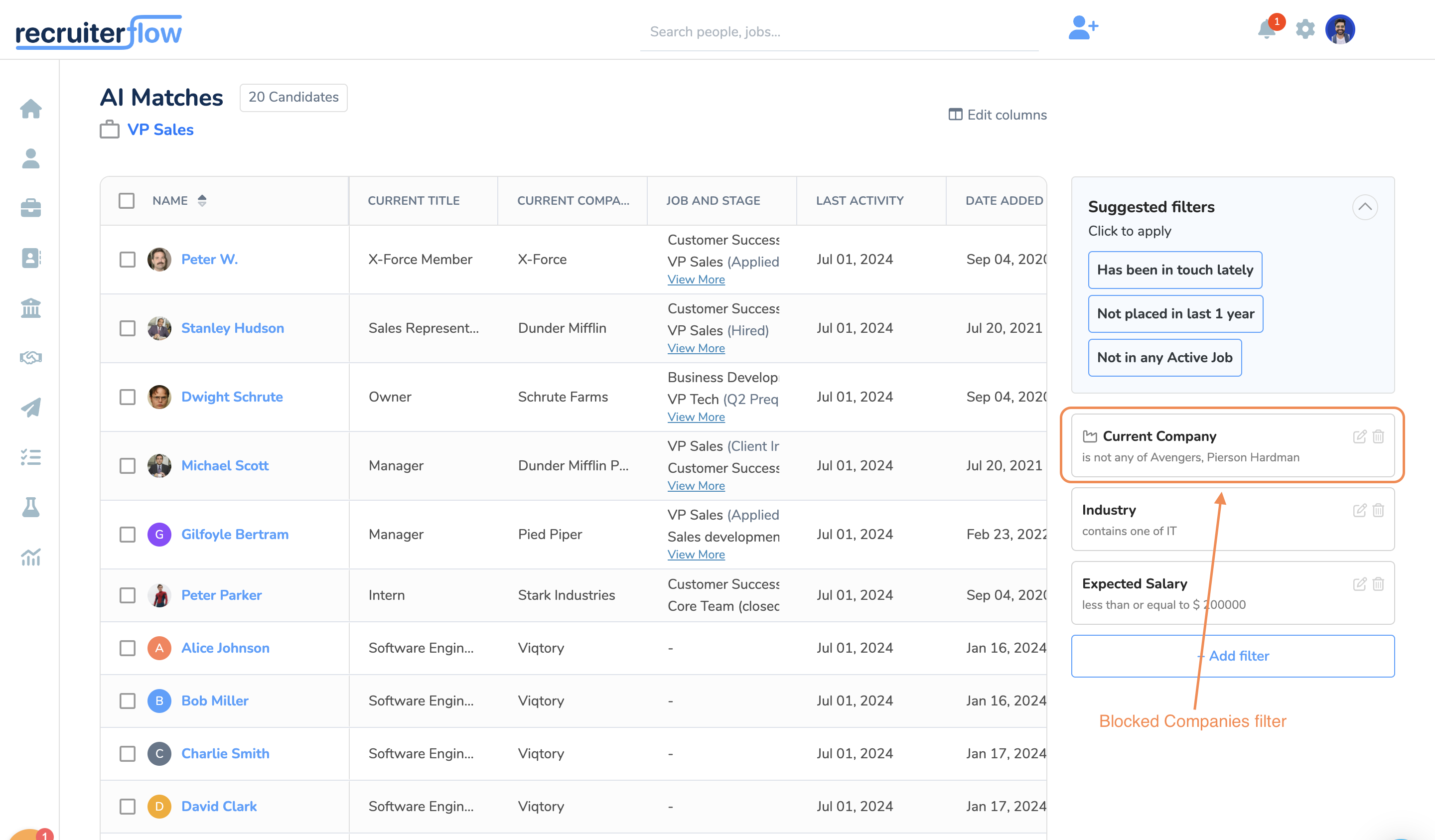
You can also help the AI improve future matches by giving feedback. For example, if you find a candidate irrelevant (e.g., Candidate C), click ‘Less experience’ and provide feedback (e.g., ‘Candidate should have at least “5” years of experience’).
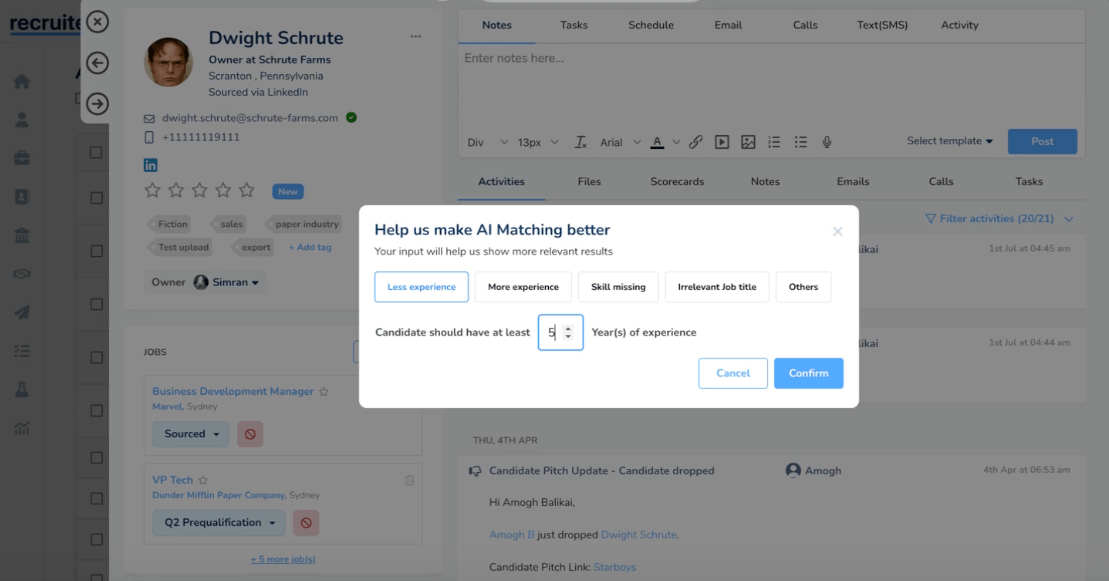
Deploy pre-screening chatbots. AI chatbots like Olivia (Paradox) or Mya ask candidates role-specific questions (e.g., “Walk me through your lead-gen strategy”) and score responses in real time.

Agency RecruitRocket used Mya to screen 500+ applicants for a UX role. The bot auto-rejected 60% (mismatched skills) so recruiters could dive deep with the top 40%.
Automation is an ongoing process. Stay sharp by:
- Auditing your algorithms: Ensure they don’t penalize non-traditional career paths.
- Keeping humans in the loop: Use AI for screening, not deciding.
- Testing regularly: Run dummy resumes to check for false negatives.
Josh Bersin recommends combining AI scores with human review to avoid “robot bias.”
4. Implement Automated Scheduling and Interview Assessments
Juggling calendars and manually assessing candidates is a time-sucking black hole. How many hours have you lost this week trying to align interview slots or deciphering vague answers to “What’s your greatest weakness?” The good news? Automation can rescue you.
Automated scheduling tools eliminate the back-and-forth by letting candidates self-serve. For example, a tech startup reduced time-to-fill by 40% after adopting Calendly for interviews.
Automated scheduling and assessments also help reduce bias. For example, GapJumpers found AI assessments increased diversity in hires by 33% by ignoring demographics and focusing on skills.
Here’s how to make it work:
- Use tools like Calendly, GoodTime, or X.ai: Sync with your calendar so candidates see only available slots.
- Embed scheduling links in emails or chatbots: “Pick a time that works for you” boosts candidate experience.
- Set buffer times: Avoid burnout by automating 15-minute gaps between interviews.
Also, add automated reminders (SMS or email) to slash no-show rates by up to 50% (Humanly.io).
You can integrate scheduling tools (e.g., Calendly) with Recruiterflow via Zapier to send screening call invitations and status updates to candidates.
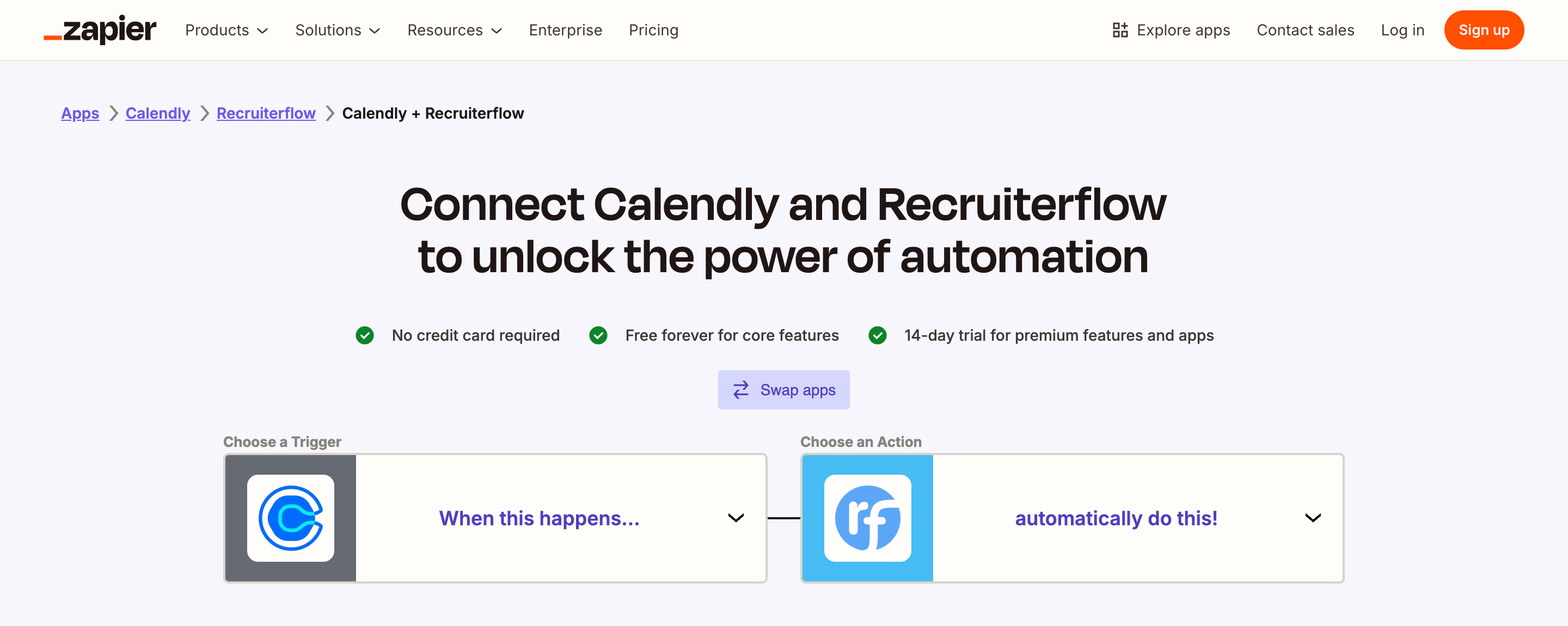
Recruiterflow primarily connects with Google Calendar and Outlook/Office365 to ensure calendar events and emails related to candidates or contacts are automatically saved to their respective profiles.
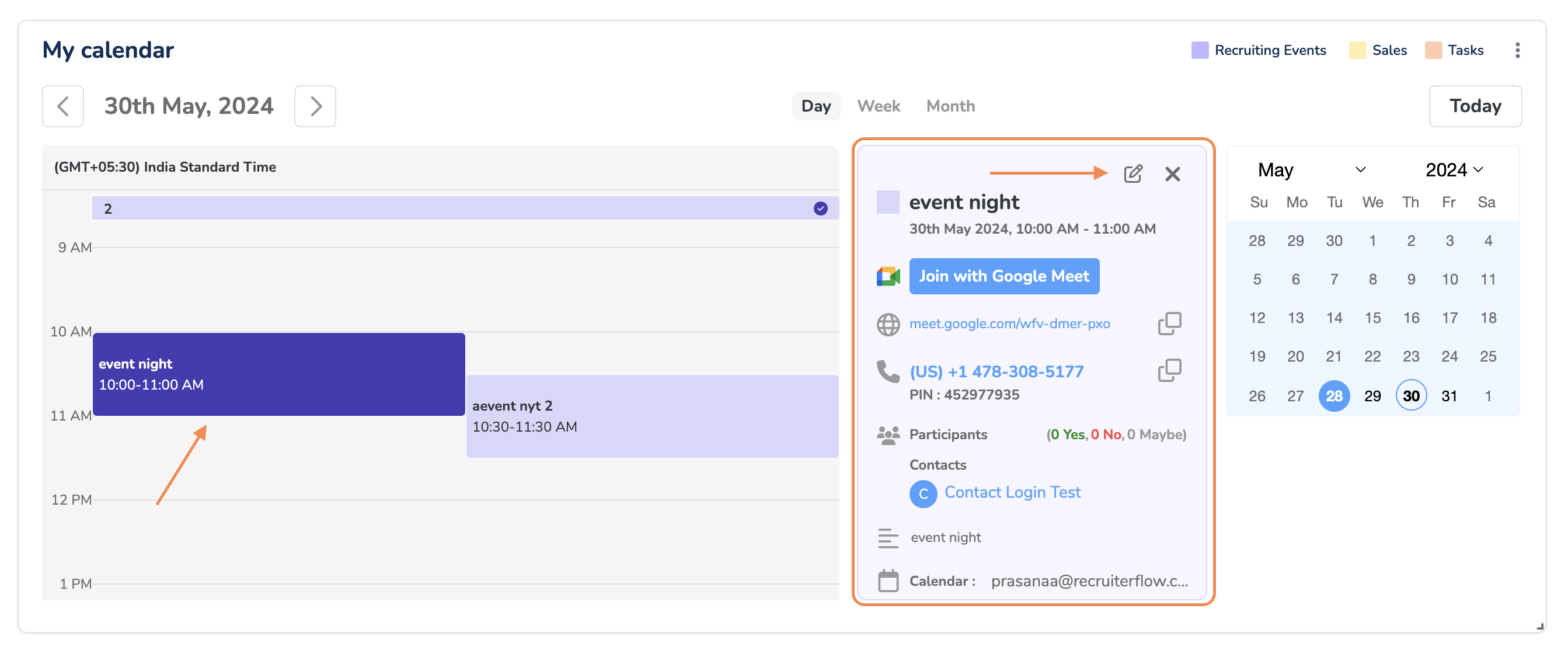
This way, Recruiterflow supports automated event creation. Triggers in Recruiterflow can create calendar events in tools like Outlook or Google Calendar when specific actions occur (e.g., new candidate updates).
You can also schedule interviews directly from candidate profiles. You can add interviewers, dates, times, etc. Events sync with connected calendars to avoid conflicts.

Ever interviewed a candidate who aced the chat but bombed the actual job? AI-powered assessments help you cut through the fluff. Unilever saved 70,000 hours annually by using AI assessments to screen 250,000 applicants (Harvard Business Review).
Here are some tools you can try:
- Recruiterflow: Rates candidates based on your assessments while interviewing them.
- HireVue: Analyzes video interviews for keywords, tone, and body language.
- Codility: Tests coding skills in real-time with auto-graded challenges.
- Pymetrics: Uses neuroscience games to predict cultural fit.
Recruiterflow’s interview scorecards allow you to rate candidates based on different criteria and even include feedback from everyone involved.
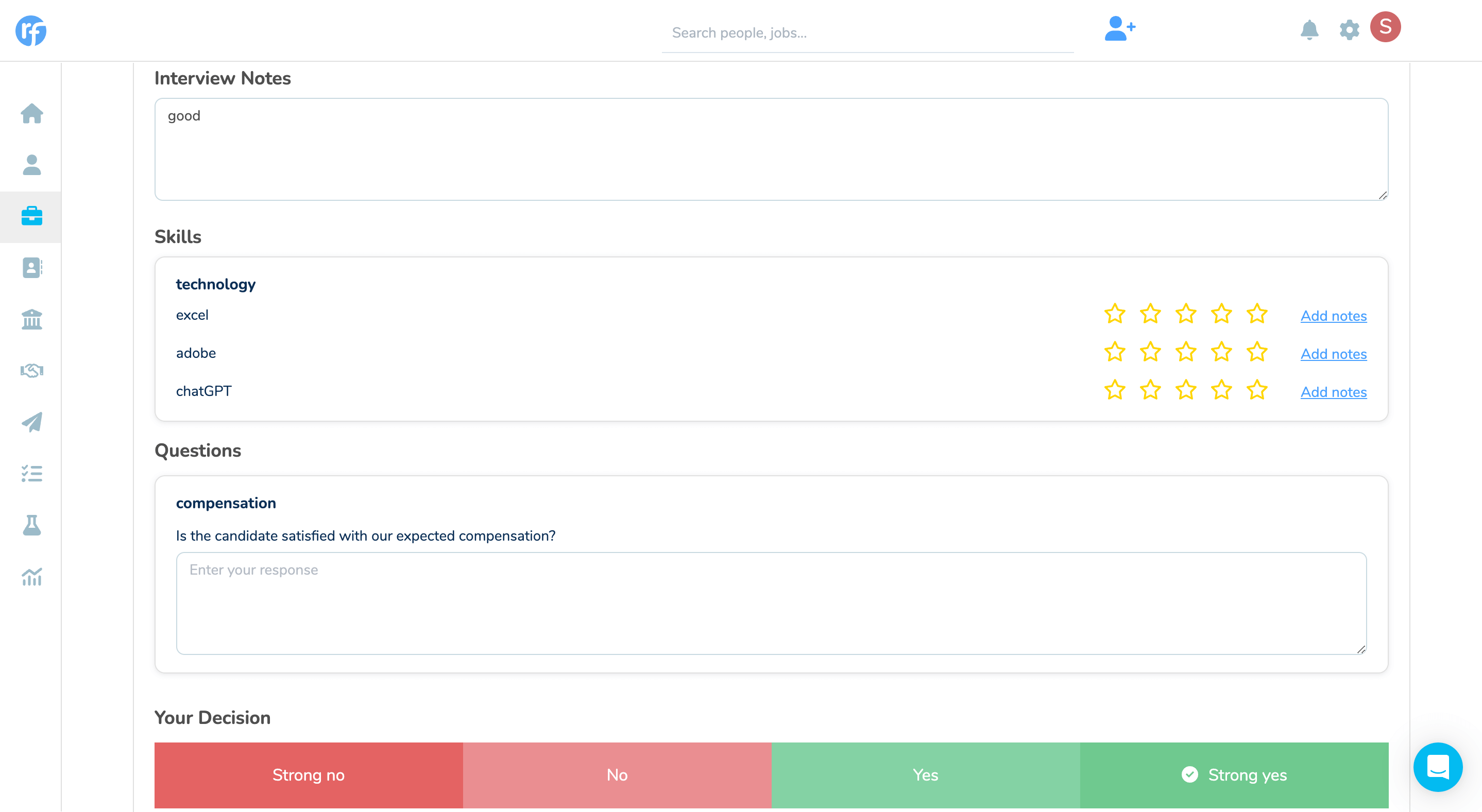
Automate video interview assessments. 68% of candidates prefer video interviews over phone screens (2023 Gartner survey). Platforms like HireVue or Spark Hire analyze video responses for keywords, tone, and even body language.
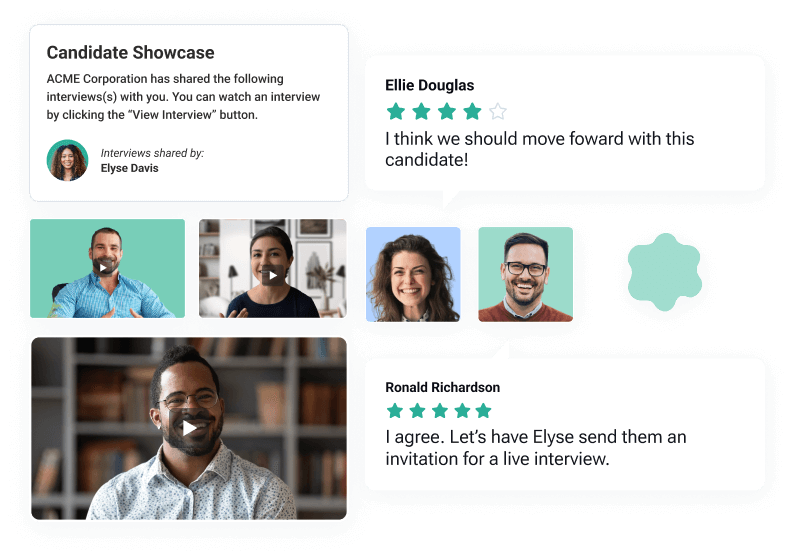
5. Optimize Recruitment with a CRM System
Have you spent weeks nurturing a star candidate, only to lose them because they slipped through the cracks of your messy email threads and spreadsheets? Frustrating, right?
That’s where a Candidate Relationship Management (CRM) system swoops in to save the day. Think of it as your recruitment wingman—it organizes, automates, and personalizes interactions with candidates, and turns your talent pool into a well-oiled machine.
Companies using recruitment CRMs see a 40% reduction in time-to-fill and 25% higher candidate satisfaction rates (LinkedIn Talent Solutions Report, 2024).
A CRM isn’t just for sales teams. For recruiters, it’s crucial:
- Centralizes candidate data (resumes, communication history, skills) in one place.
- Automates follow-ups to keep candidates engaged without manual effort.
- Identifies passive candidates who might be perfect for future roles.
- Boosts employer branding with personalized touchpoints.
The 3 must-have features in your recruitment CRM are:
- Automated Workflows (e.g., email sequences, task reminders).
- Analytics Dashboard to track engagement metrics.
- Mobile Access so you can manage candidates on the go.
Here’s how to get started:
1. Automate Candidate Nurturing Campaigns
Instead of sending generic emails, use your CRM to create tailored drip campaigns. Platforms like Recruiterflow or Gem let you schedule emails and track opens & clicks.
For example, you can use Recruiterflow to set up automated emails and messages for:
1. Post-application updates:
Thank you for applying!

Disqualification email.
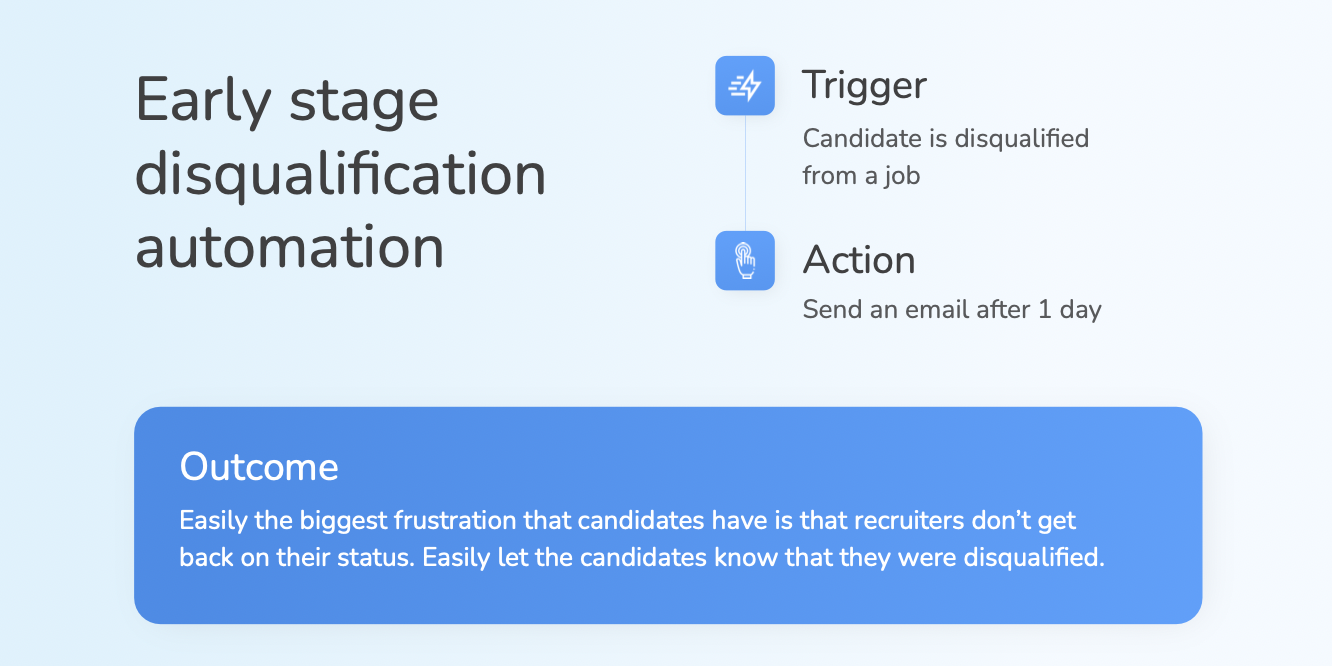
Good luck SMS before the interview.
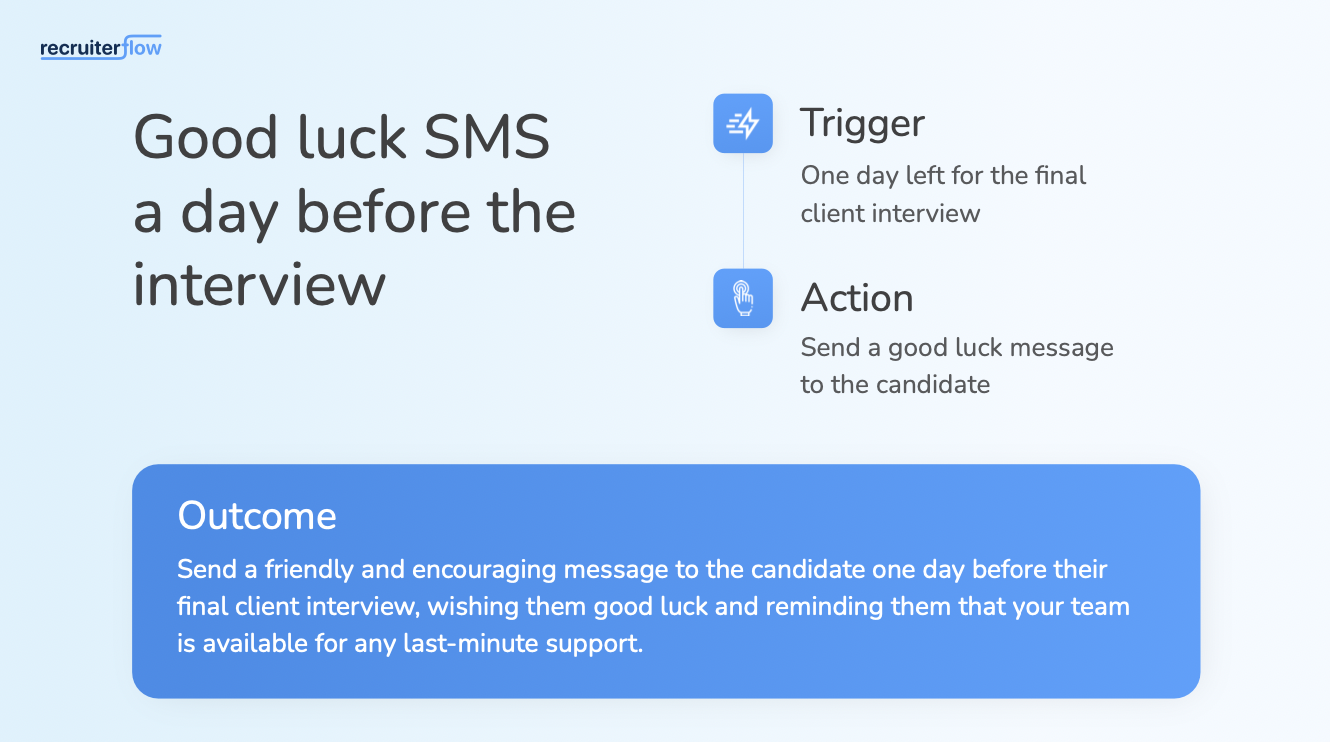
2. Birthday/anniversary greetings to build rapport.
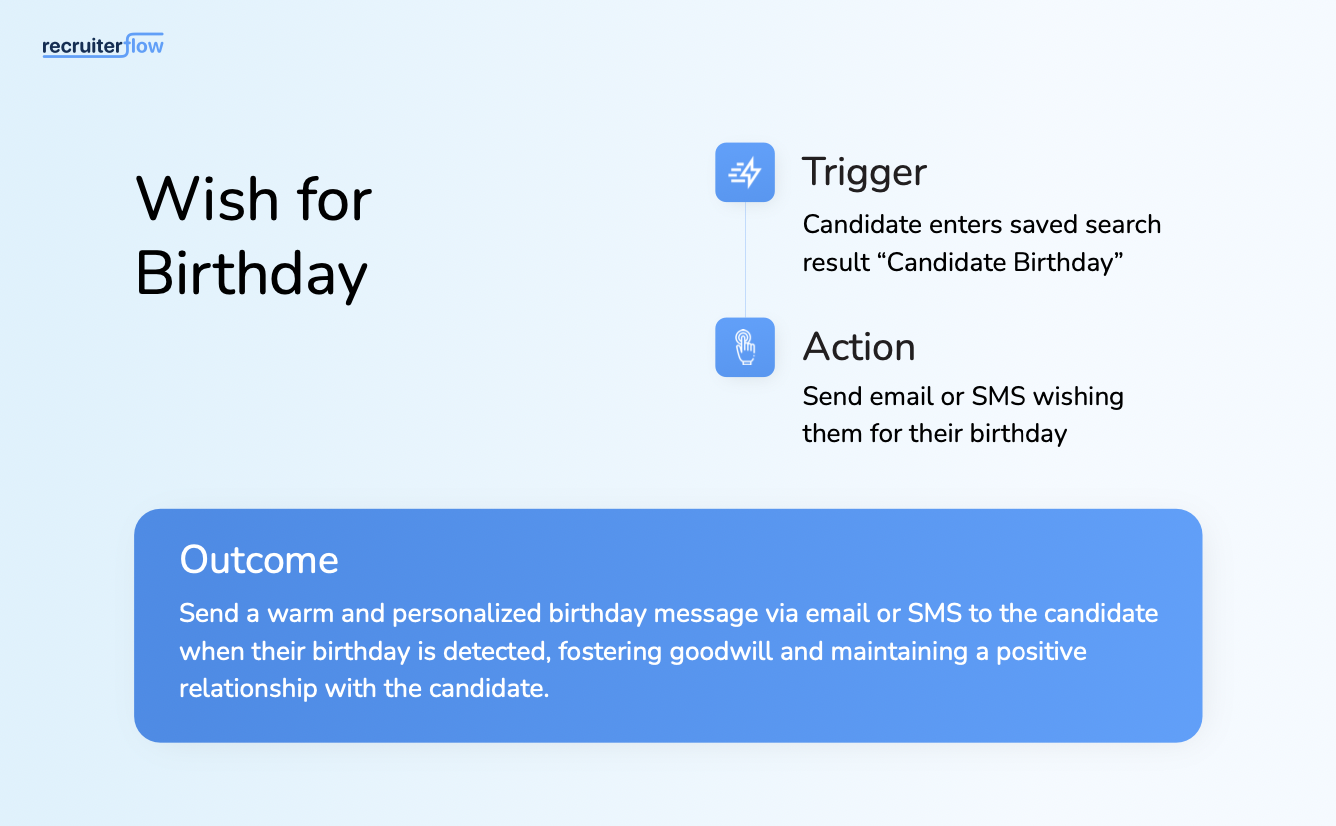
3. Nurturing candidates:
Stay in touch with the candidate over the guarantee period.

Auto engage candidates whose contracts are ending in the next 30 days.
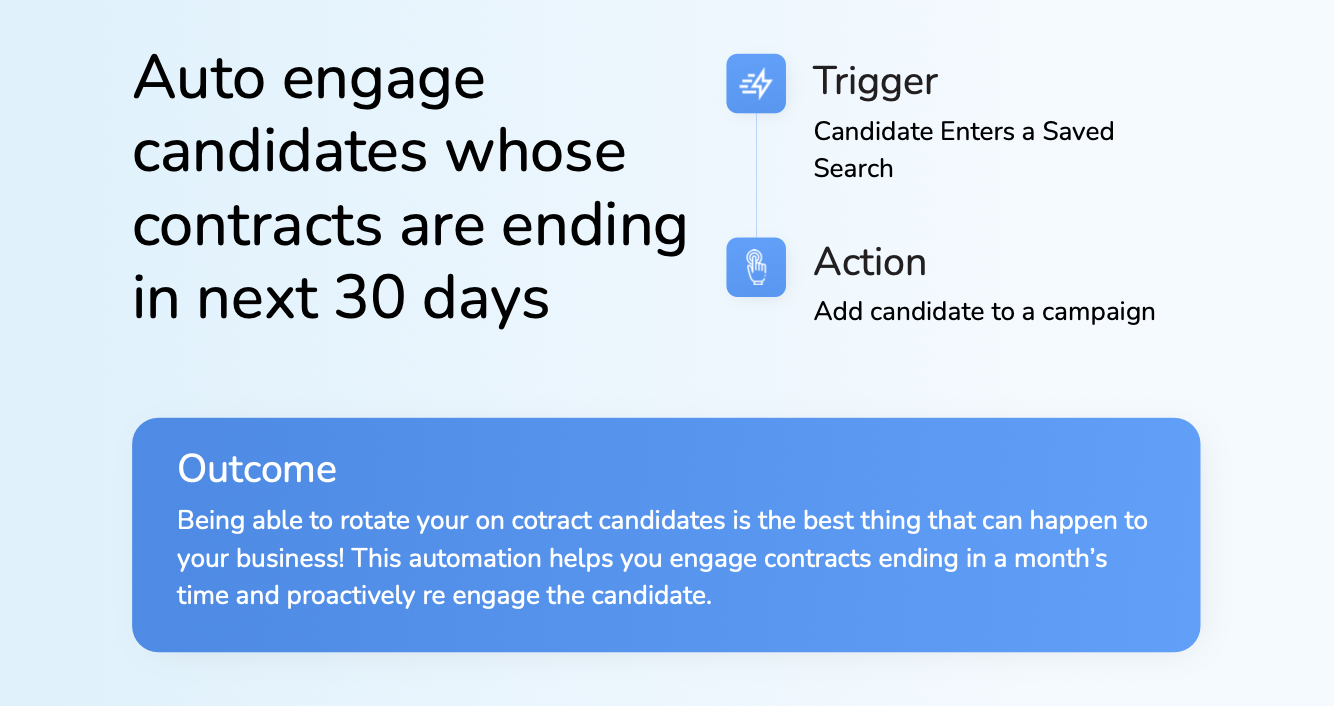
Nurture five-star candidates.
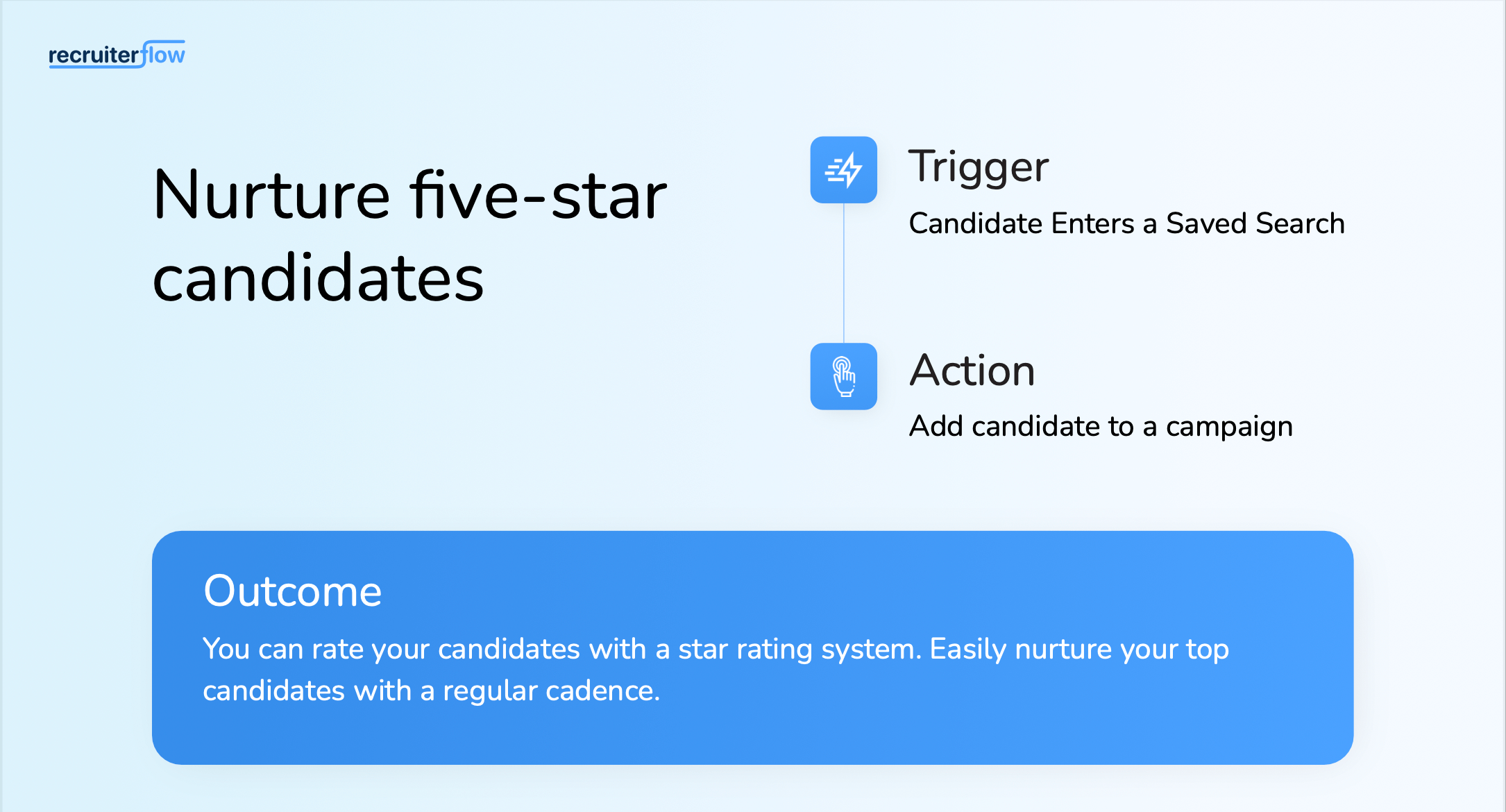
2. Segment Your Talent Pool Like a Pro
Not all candidates are the same. You can easily segment candidates into specific groups based on your chosen criteria in Recruiterflow. Use tags and filters to categorize them:
- By skill (e.g., “Python Developer,” “Marketing Manager”).
- By experience level (Entry-level, Senior, Executive).
- By engagement stage (Cold, Warm, Hot Lead).
Select the candidates you want to segment, click ‘Add Segment’ button at the top, and then click ‘Create a new Segment’ button.

Next, start adding filters by clicking the ‘Add Filters’ button.
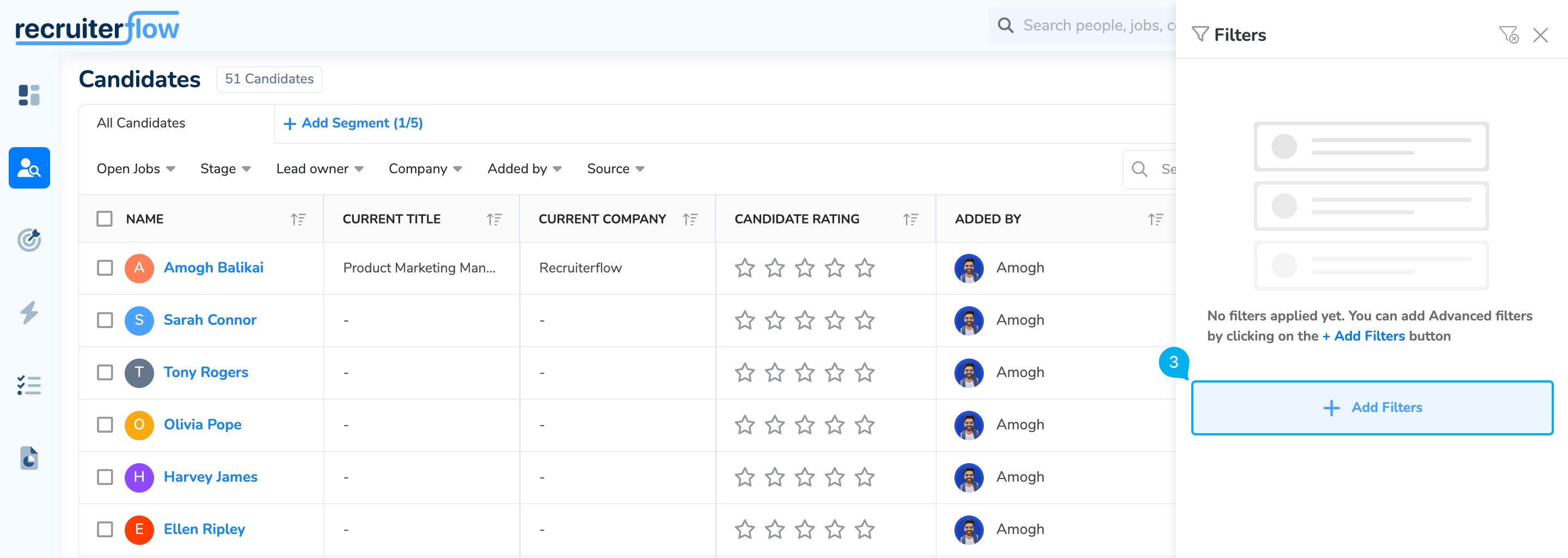
To tag your candidates on Recruiterflow, select candidate(s) and click the ‘Add to tag’ button at the top.
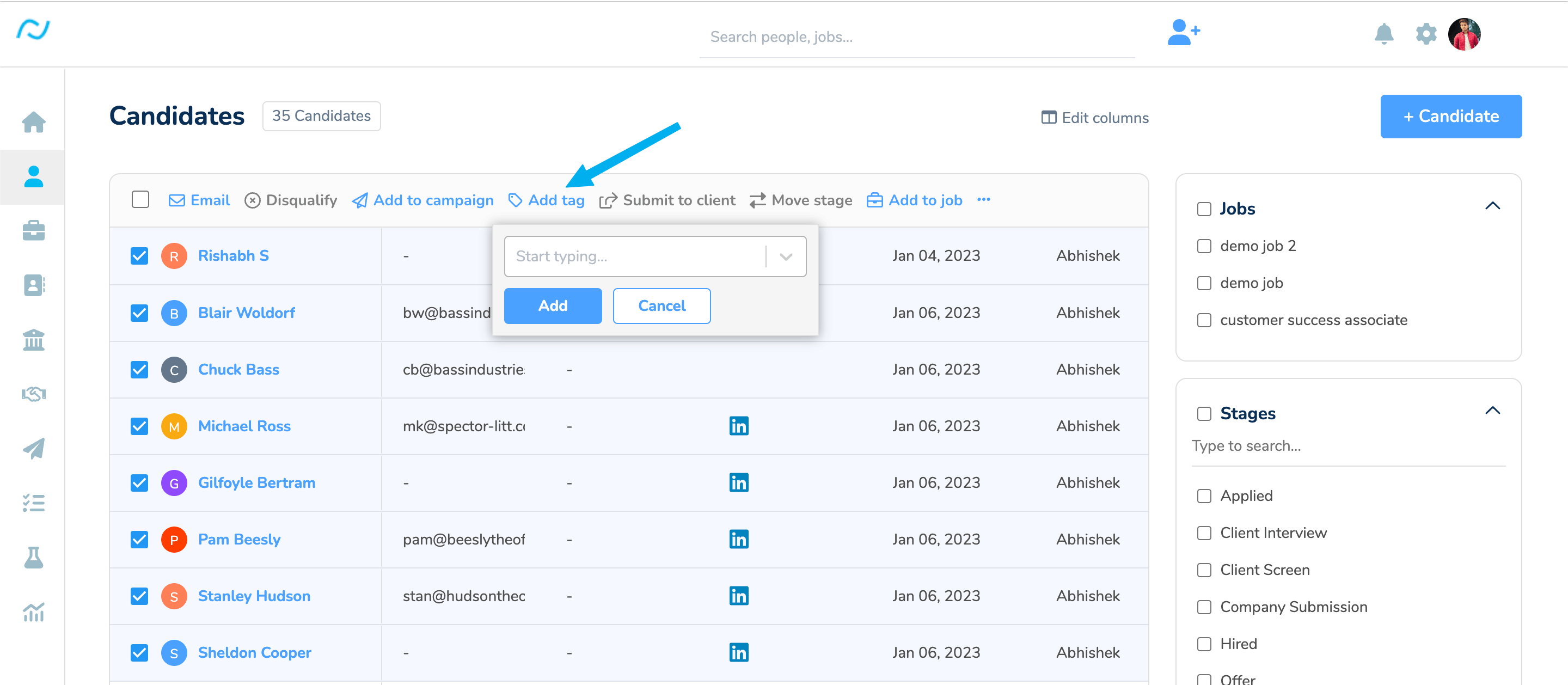
Pro Tip: Filter your top candidates with the ‘Candidate rating’ filter and set reminders to check in quarterly.
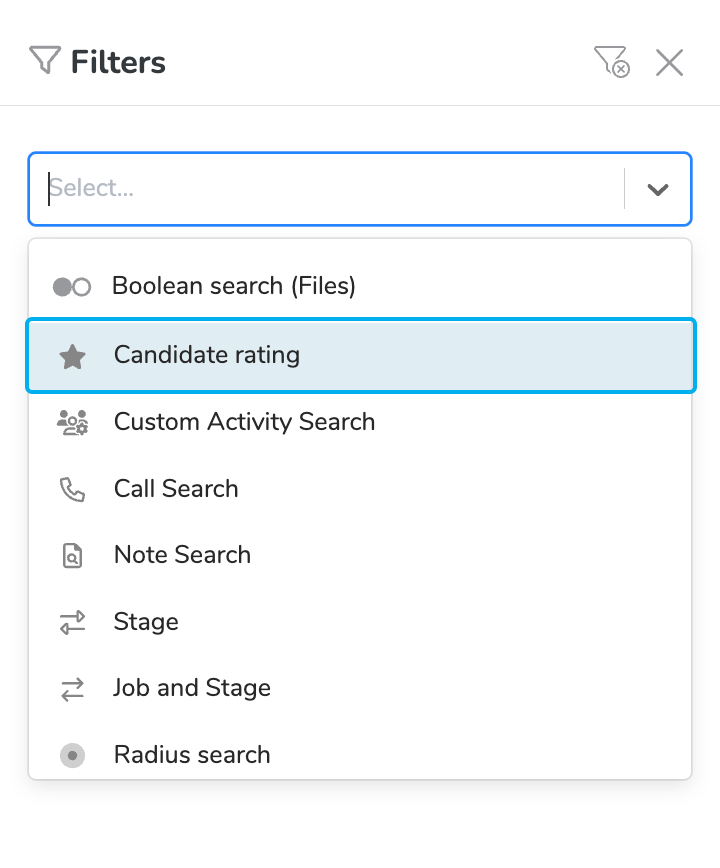
3. Sync Your CRM with Your ATS for Seamless Workflows
Why juggle two systems when they can talk to each other? Most CRMs integrate with ATS platforms. For example, when a candidate applies via your ATS, your CRM auto-updates their profile and triggers a welcome email.
Better yet, use a tool like Recruiterflow that is both an ATS and a CRM. Recruiterflow goes beyond just email automation. You can also set up custom workflows to automate all your recruitment processes.
Use Recipes, Recruiterflow’s automation tool, to trigger actions like:
1. Sending submission email to client when a candidate stage changes to ‘Client Submission’.
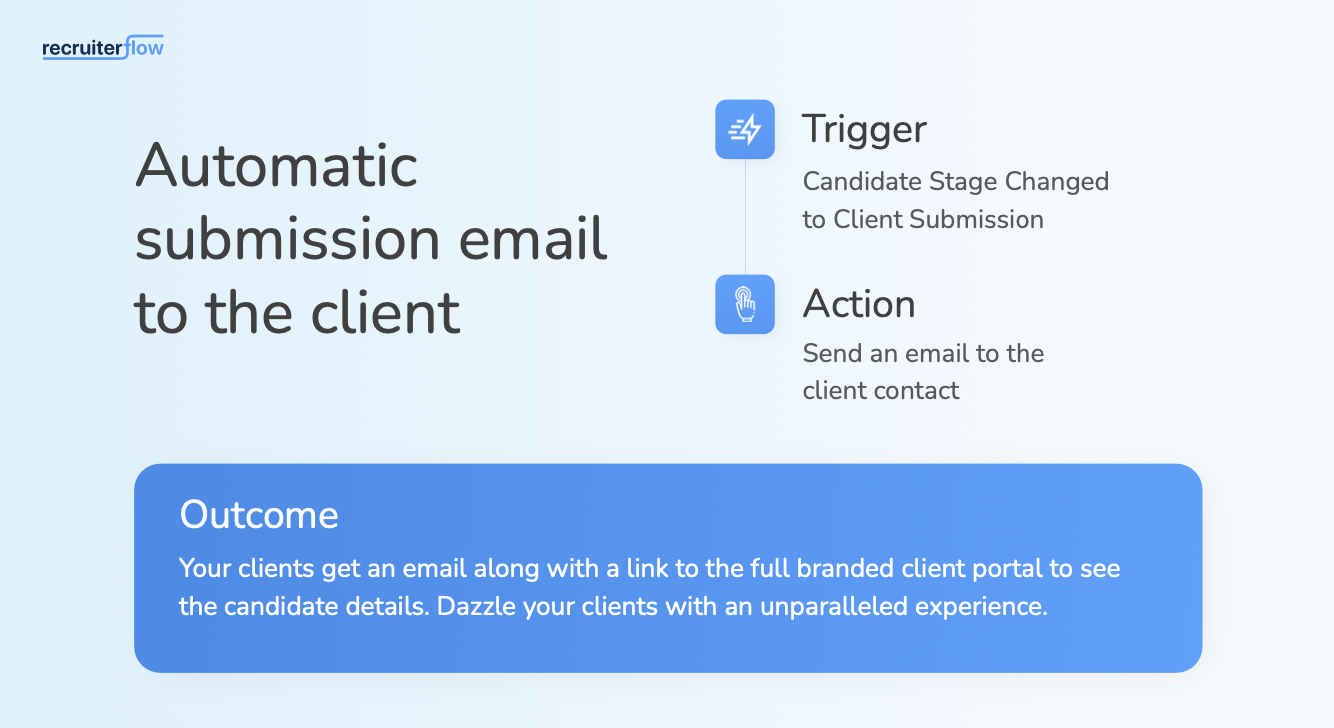
2. Creating a task for the back office team member to start the onboarding process.

3. Notifying team members when a job is opened.
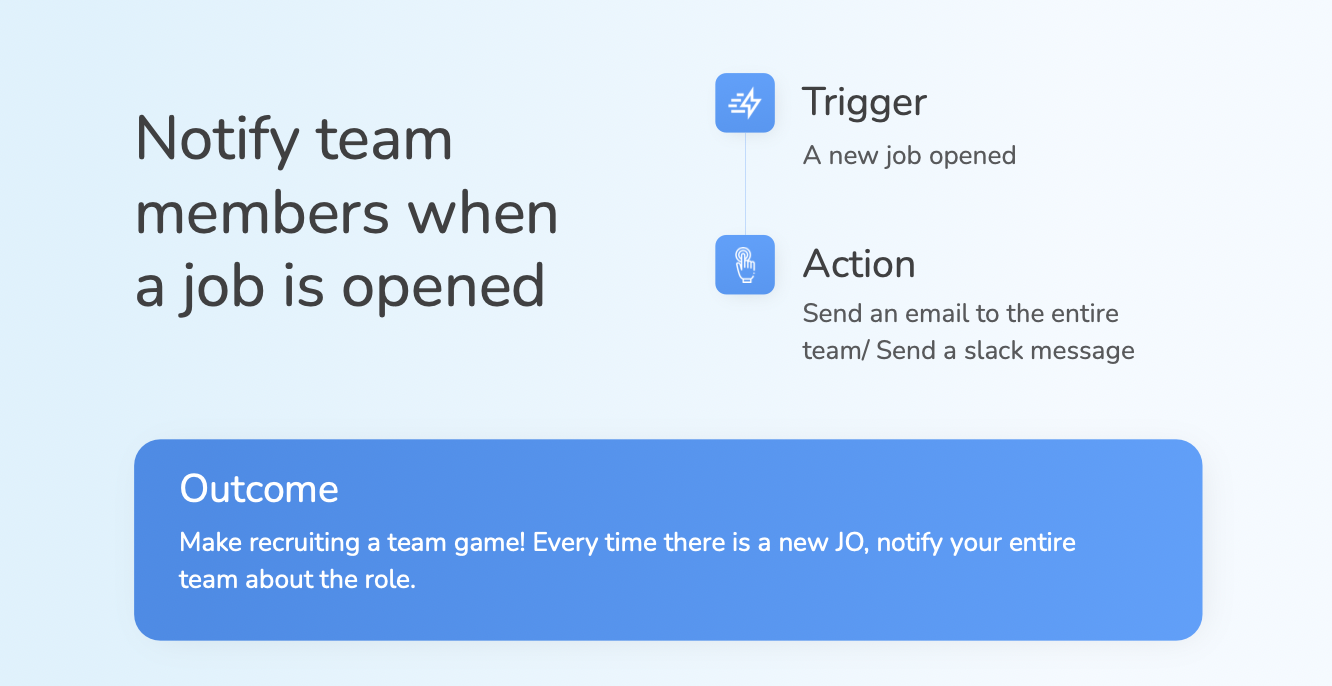
For advanced workflows, connect Recruiterflow to platforms like Google Sheets via Zapier to sync candidate data and automate external communications.
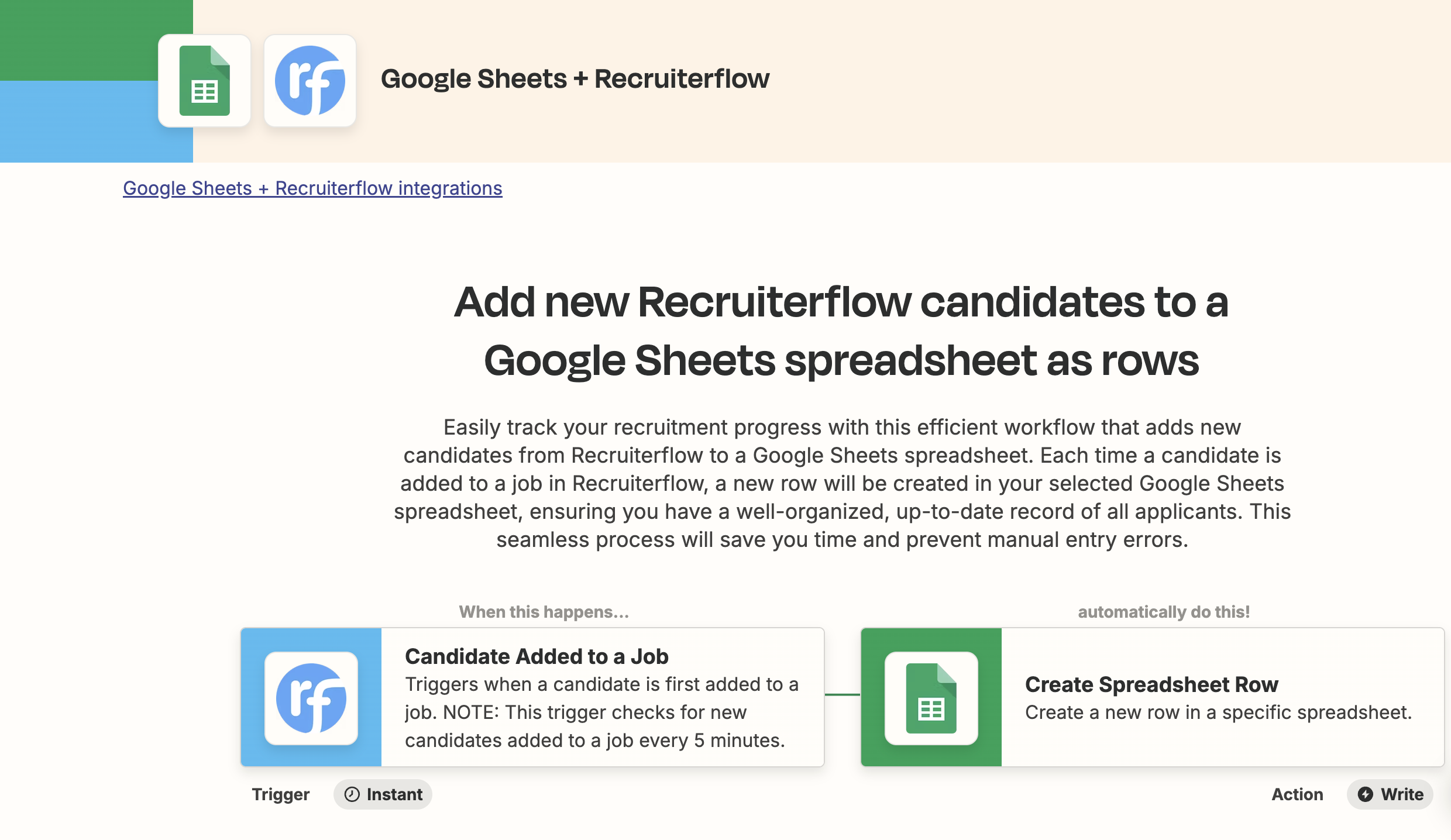
With Recruiterflow, you can manage your clients as well. Recruiterflow makes it simple to manage client relationships along with candidate relationships in one easy-to-use interface.
To implement Recruiterflow’s CRM for client relationship management, get started with these 2 simple steps:
1. Upload existing client data (e.g., contact details, interaction history) into the CRM using CSV files or direct integrations with platforms like LinkedIn or Gmail.

Optionally, you can organize your client data by assigning tags based on industry, deal size, or engagement level to prioritize high-value relationships.
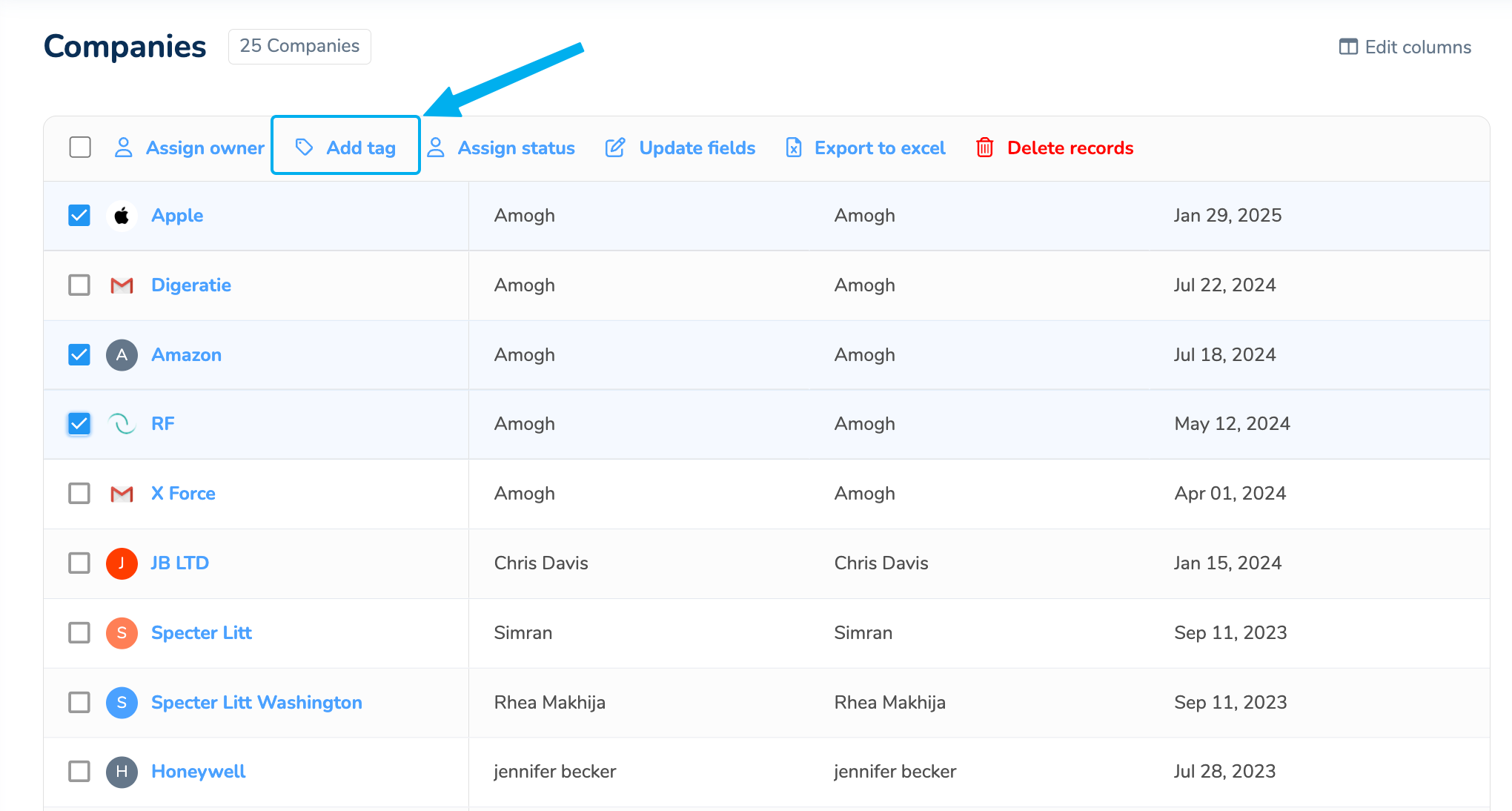
2. Set up your sales pipeline. Head to ‘Settings’ > ‘CRM Settings’ and navigate to the ‘Deals pipeline’ section to start customizing your sales pipeline.

Tailor stages like “Qualified to Buy”, “Contract Sent”, and “Closed Deal” to match your agency’s workflow. Use the customizable Kanban view to visualize client opportunities and potential revenue streams.
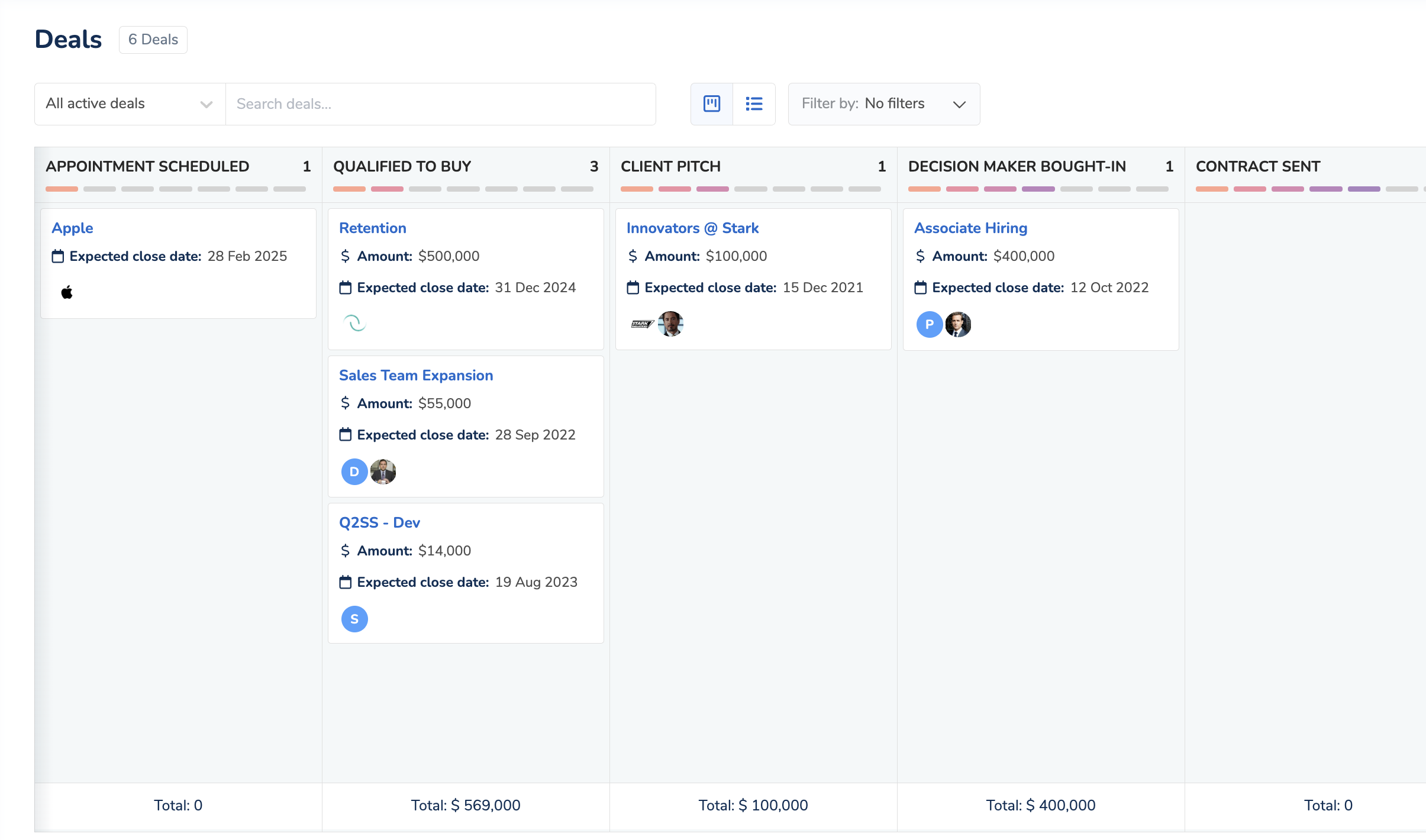
6. Enhance Background Checks and References with AI
Background checks and reference calls are necessary evils in recruitment. They’re time-consuming, prone to human error, and let’s face it: no one enjoys chasing down former employers or squinting at PDFs to verify employment history.
For example, 43% of HR teams spend 3+ days verifying a single candidate’s employment history (SHRM, 2024). And 1 in 5 reference checks contains inaccuracies due to rushed or biased human input (HireRight Report).
Sound familiar? AI steps in to cut the noise. AI tools like Checkr or GoodHire scan global databases in minutes–cross-reference criminal records, education, employment history, etc.
For instance, Checkr’s AI reduces the average screening time from 5 days to 2 hours by auto-flagging discrepancies. Hilton reduced its time-to-hire from 60 days to 7 days by letting AI handle criminal record checks and employment verification.

Automated reference analysis tools (e.g., Xref) use NLP (Natural Language Processing) to analyze tone, keywords, and consistency in reference responses.
A healthcare recruiter used Xref’s sentiment analysis to spot a reference who repeatedly hesitated when asked about a candidate’s “attention to detail.” The AI flagged it, and the recruiter dodged a bad hire.
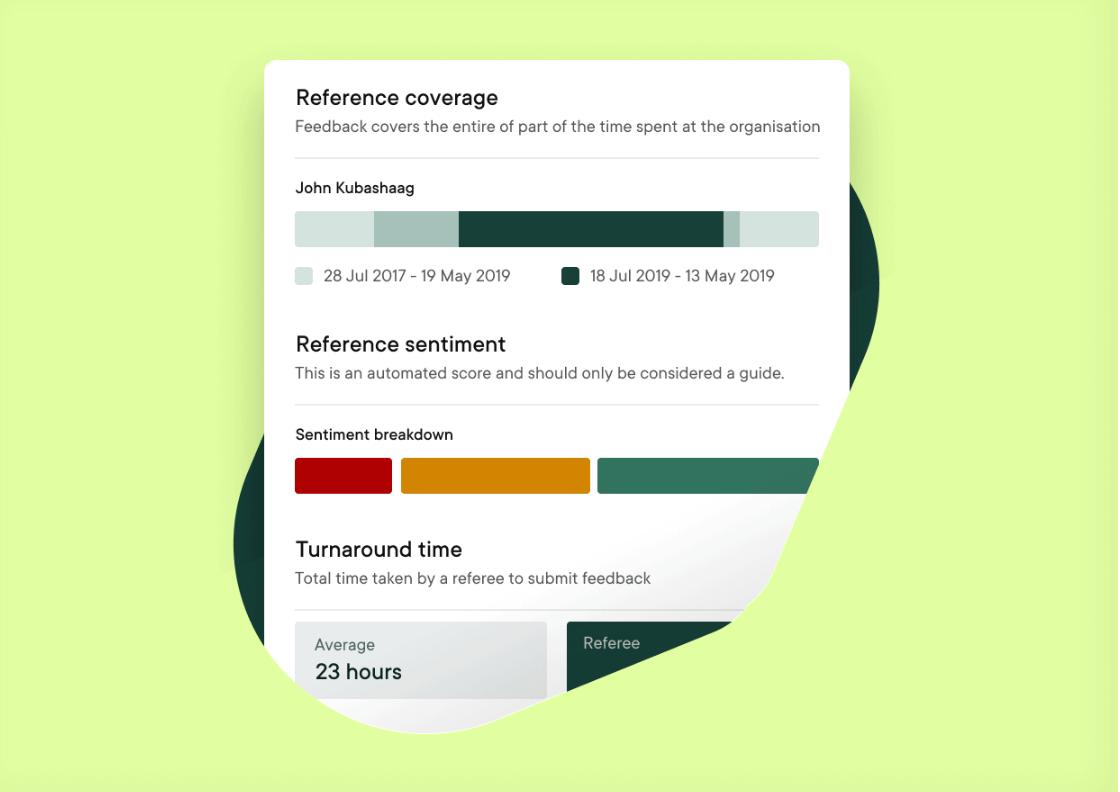
Instead of skimming surface-level answers, AI tools like SkillSurvey analyze patterns in reference feedback. For example, if 3+ references mention a candidate’s “collaboration skills,” the AI highlights it as a strength. Red flags (e.g., vague responses about punctuality) trigger alerts for recruiters to investigate.
AI also follows strict compliance frameworks (like FCRA or GDPR) and ensures checks are fair and legally sound. Tools like Sterling auto-update their systems to comply with regional laws—critical for remote hiring.
Here’s what to prioritize when choosing an AI-powered background check tool:
- Fraud Detection
AI spots fake diplomas, inflated job titles, and ghost employers by cross-referencing blockchain-verified records (like MIT’s digital diplomas). For example, Certn uses AI to scan social media for red flags, like hate speech or illegal activity, saving you from PR disasters. - Bias Reduction
Traditional checks unfairly target marginalized groups. AI evaluates everyone against the same metrics. 70% of Americans want employers to stop blanket bans on minor offenses—AI makes this possible. - Global Compliance
Tools like Zinc handle international right-to-work checks in minutes, even verifying candidates in 100+ countries without legal headaches.
And here’s your cheat sheet for AI background check tools:
- Checkr: AI-powered, FCRA-compliant checks with real-time tracking. Loved by Netflix and Airbnb for its fraud detection.
- Good Egg: Blends automation with human reviews for PBSA-accredited screenings. Integrates with Workday and Greenhouse.
- HireRight: Best for enterprises needing global criminal checks and continuous monitoring.
Pro Tip: Integrate these tools with your ATS (e.g., Recruiterflow) to auto-trigger checks after a candidate accepts an offer.
Is AI always accurate? Sure, AI can mess up (remember Amazon’s biased hiring algo?). But here’s the fix:
- Choose vendors like Certn or Checkr that publish bias audits.
- Train your team to spot algorithmic quirks.
7. Harness Automated Reporting for Better Insights
As recruiters, you’re drowning in data. Resumes, interview feedback, time-to-hire stats—it’s a lot. But what if you could turn that chaos into clarity?
Automated reporting lets you glean actionable insights to make smarter, faster decisions. Here’s why automated reporting is a recruiter’s secret weapon:
- Save 8+ hours per week by eliminating manual spreadsheets (LinkedIn Talent Solutions).
- Reduce human error in data entry; ensure your metrics are actually reliable.
- Spot trends in real-time, like which sourcing channels deliver the best candidates.
Focus on automating these metrics to stay ahead:
- Time-to-Hire: Track how long it takes to fill roles. An agency reduced time-to-hire by 50% after automating this metric.
- Source of Hire: Identify which platforms (e.g., LinkedIn, Indeed) drive top talent.
- Cost-per-Hire: Calculate expenses for job ads, tools, and any fees.
- Candidate Drop-off Rate: Pinpoint where applicants abandon your process (e.g., lengthy applications).
- Offer Acceptance Rate: Gauge if your compensation packages are competitive.
Follow these best practices to maximize your data:
- Set Clear KPIs: Align metrics with business goals (e.g., “Reduce cost-per-hire by 15% in Q1”).
- Schedule Regular Reviews: Use automated tools to generate weekly/monthly reports—no last-minute scrambles.
- Train Your Team: Ensure recruiters can interpret dashboards. For example, host a 30-minute “Data Literacy” workshop.
Forget spreadsheets, use these tools to automate reporting like a pro:
- Recruiterflow Analytics: Pre-built dashboards for tracking pipeline health and diversity metrics.
- Tableau: Visualize hiring trends with drag-and-drop charts.
- Google Looker Studio: Free tool to merge data from ATS, CRM, and job boards into one dashboard.
Recruiterflow’s automated reports let you analyze the current health of the pipeline, both sales and recruiting, at a glance. You get real-time stats that help you predict your agency’s revenue, measure your team’s performance, and optimize both your existing sales and hiring pipeline.
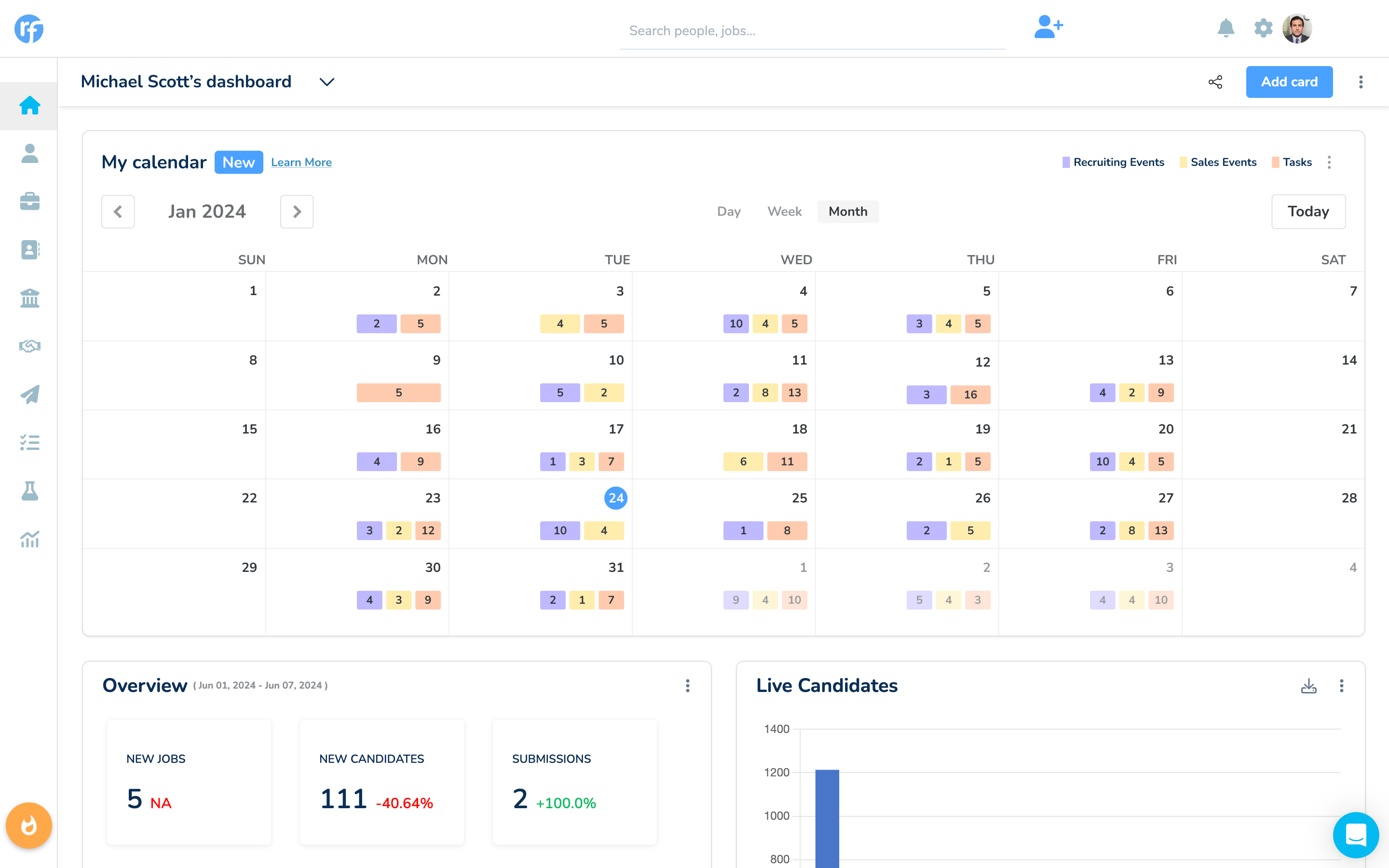
You’ll have access to both candidate and client reports in one place. You can track metrics like:
- Number of candidates sourced
- Sourcing channel efficiency
- Number of screening, submittals, client interviews, and placements.
- Conversion rate at each stage of your recruiting process
- Time to fill and fill ratio
- Revenue by each user
- Conversion rate of your sales pipeline
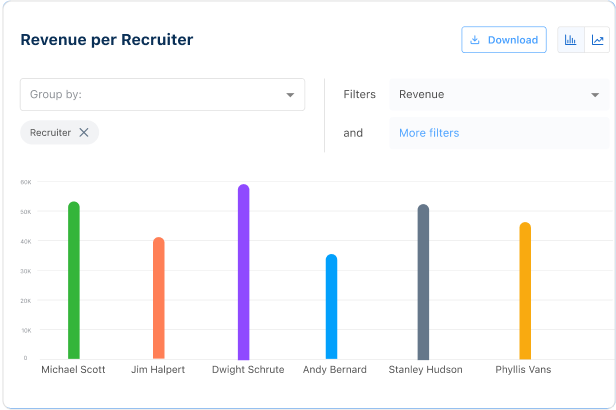
Also read: AI Recruiting in 2025: A Complete Guide
Best Recruitment Automation Software in 2025
Before we take a deep dive into the best recruitment automation tools, here are the key features you need to look for in recruitment automation software:
- Applicant Tracking System (ATS): This is your bread and butter. It has to keep all your applications in one place, track candidates, and make everything organized. Think of it like your recruitment HQ.
- AI-Powered Candidate Matching: You want software that can find the right people. AI can scan resumes and job descriptions and tell you who’s a good fit.
- Resume Parsing: This thing should automatically pull info from resumes and put it into a nice, neat format. No more manual data entry, thank goodness.
- Job Board and Social Media Integration: It has to be able to post jobs on all the big sites, like LinkedIn and Indeed. You want to reach as many people as possible, right?
- Automated Communication: You need tools that can send emails and texts automatically. Like interview invites, follow-ups, and the dreaded rejection emails. Keeps everyone in the loop.
- Interview Scheduling: This is a lifesaver. It should connect with calendars like Google Calendar and Teams. No more back-and-forth emails!
- Analytics and Reporting: You want to see how things are going. Stuff like how long it takes to fill a job, how many applicants you’re getting, and where they’re coming from.
- Customizable Workflows: You should be able to set up your own hiring process so that it fits your own way of hiring and company vibe. Automate all those boring tasks.
- Candidate Relationship Management (CRM): You have to keep in touch with candidates and clients. A good CRM helps you build relationships and keep everyone happy.
- Mobile Accessibility: You need to be able to access your data on your phone. Cloud-based and using cloud management software is the way to go. You never know when you’ll need to check something on the go.
Here’s all the best recruitment automation software at a glance:
| Software | Overview | Key Automation Features | Pricing |
| Recruiterflow | ATS and CRM for recruiting & staffing agencies. Simplifies hiring, increases placements, and saves time. | Workflow automation (“Recipes”), email automation, resume parsing, AI-driven matching, interview scheduling, candidate sourcing, pipeline management, client portal, social media & job board integration. | Starts from $119/user/month. |
| Workable | Comprehensive recruitment platform for SMBs. AI-powered tools and user-friendly interfaces. | AI-powered sourcing, automated resume screening, one-click job posting (200+ boards), interview scheduling, and customizable workflows. | Starts at $129/job/month, custom plans available. |
| Manatal | AI-driven recruitment software for SMBs. Combines ATS with advanced automation. | AI-based recommendations, automated resume parsing & scoring, social media enrichment, and workflow automation. | Starts at $15/user/month. |
| Paradox | Conversational AI assistant (“Olivia”) for automated candidate engagement. | AI chatbot for pre-screening& FAQs, automated interview scheduling, real-time candidate engagement (text & chat), and ATS integration. | Custom pricing. |
| hireEZ | Sourcing-focused tool for efficient passive candidate engagement. | AI-powered sourcing (45+ platforms), automated email outreach, candidate rediscovery, ATS & CRM integration. | Starts at $200/user/month, enterprise plans available. |
| VidCruiter | Recruitment suite for mid-to-large enterprises. Specializes in video interviewing and end-to-end automation. | Automated video interviews, AI-driven ranking, workflow automation (onboarding, docs), customizable interview templates. | Custom pricing. |
| Zoho Recruit | Versatile platform for small businesses, agencies, and enterprises, with seamless Zoho product integration. | Automated resume parsing & matching, workflow automation, AI chatbot, Zoho CRM & third-party integration. | Starts at $25/user/month (Standard), higher-tier plans available. |
| Greenhouse | Popular recruitment software for enterprises. Offers robust talent acquisition and onboarding tools. | Automated job posting & tracking, AI-driven scoring, workflow automation (interviews, feedback), advanced analytics. | Custom pricing. |
| SeekOut | AI-powered platform for talent sourcing and diversity hiring. | AI-driven talent search, automated diversity insights, workflow automation, and ATS integration. | Custom pricing. |
| Recruit CRM | All-in-one ATS and CRM for global staffing firms. | Automated resume parsing & matching, workflow automation (client & candidate), email automation, and integrated reporting. | Starts at $69/user/month. |
| Team Engine | Recruitment platform for industries like construction and home services. Focuses on candidate communication. | Automated pre-screening & interview scheduling, personalized text & email communication, workflow automation, and mobile-friendly interface. | Custom pricing. |
1. Recruiterflow
Recruiterflow is an ATS and CRM mashed together. You can track candidates and keep clients happy all in one spot. It’s built for recruiting and staffing agencies. Your agency gets all the tools to manage your recruitment operations.

Agencies say it makes hiring way easier by taking care of all the boring stuff. Plus, it’s super easy to use, which is always a bonus, right?
With Recruiterflow, agencies are getting more placements, like 50% more, and saving a ton of time. Kimberly Borden, the TA Lead at PAC Solutions, eliminated manual tasks with Recruiterflow’s automation capabilities.
The results? Kimberly and her team saved over 270 days of effort in 2024.
Key Automation Features
It’s got everything to handle the grunt work.
- Workflow Automation: You can set up “Recipes” to automate stuff like sending rejection emails, scheduling interviews, and moving candidates through the process.
- Email Automation: You can send out personalized email sequences, so you’re always keeping in touch with candidates without having to write every single email yourself.
- Resume Parsing and AI-driven Candidate Matching: It automatically reads resumes and finds the best-fit candidates for the job. Helps improve the quality of hires and saves you a ton of time.
- Interview Scheduling: Recruiterflow integrates with calendars like Google Calendar and Calendly to make scheduling interviews a breeze.
- Candidate Sourcing: You can use its Chrome extension to grab candidate info from places like LinkedIn with just one click.
- Pipeline Management: You get to see what’s happening with your candidates in real-time. Helps you stay on top of things.
- Client Portal: Agencies can share candidate info with clients at specific stages.
- Social Media and Job Board Integration: It helps you post jobs on places like LinkedIn, Indeed, and Glassdoor automatically. So, everything’s always up-to-date.
Pricing
They’ve got a few different plans, depending on what you need.
- Advanced Plan: $119 per user per month.
- Custom for large teams.
Recruiterflow gives you a 14-day free trial for all the plans. So you can give it a spin before you commit.
2. Workable
Workable is a comprehensive recruitment automation platform for small and medium-sized businesses (SMBs). It focuses on simplifying the hiring process with AI-powered tools and user-friendly interfaces.
Key Automation Features
- AI-powered candidate sourcing and recommendations.
- Automated resume screening and ranking.
- One-click job posting to over 200 job boards.
- Interview scheduling with calendar integrations.
- Customizable hiring workflows.
Pricing
Starts at $129 per job per month, with custom plans available for larger organizations.
3. Manatal
Manatal is an AI-driven recruitment software tailored for SMBs. It combines ATS functionalities with advanced automation to enhance hiring efficiency.
Key Automation Features
- AI-based candidate recommendations.
- Automated resume parsing and candidate scoring.
- Social media enrichment for candidate profiles.
- Workflow automation for candidate tracking and communication.
Pricing
Starts at $15 per user per month
4. Paradox
Paradox is known for its conversational AI assistant, “Olivia,” which automates candidate engagement and communication. It is ideal for organizations seeking a human-like AI experience.
Key Automation Features
- AI-powered chatbot for candidate pre-screening and FAQs.
- Automated interview scheduling and reminders.
- Real-time candidate engagement through text and chat.
- Integration with ATS platforms for seamless workflows.
Pricing
Custom pricing based on the size and needs of the organization.
5. hireEZ
hireEZ is a sourcing-focused recruitment automation tool that helps recruiters find and engage with passive candidates efficiently.
Key Automation Features
- AI-powered sourcing across 45+ platforms.
- Automated email outreach and follow-ups.
- Candidate rediscovery from existing databases.
- Integration with ATS and CRM systems.
Pricing
Starts at $200 per user per month, with enterprise plans available for larger teams.
6. VidCruiter
VidCruiter is a recruitment suite for mid-sized to large enterprises. It specializes in video interviewing and end-to-end hiring automation.
Key Automation Features
- Automated video interview scheduling and reminders.
- AI-driven candidate ranking and scoring.
- Workflow automation for onboarding and document collection.
- Customizable interview templates.
Pricing
Custom pricing based on the organization’s requirements.
7. Zoho Recruit
Zoho Recruit is a versatile recruitment automation platform suitable for small businesses, staffing agencies, and enterprises. It integrates seamlessly with other Zoho products.
Key Automation Features
- Automated resume parsing and candidate matching.
- Workflow automation for job postings and candidate tracking.
- AI-powered chatbot for candidate engagement.
- Integration with Zoho CRM and other third-party tools.
Pricing
Starts at $25 per user per month for the Standard plan, with higher-tier plans offering advanced features.
8. Greenhouse
Greenhouse is a popular recruitment automation software for enterprises. It offers robust tools for talent acquisition and onboarding.
Key Automation Features
- Automated job posting and candidate tracking.
- AI-driven candidate scoring and pipeline management.
- Workflow automation for interview scheduling and feedback collection.
- Advanced analytics and reporting.
Pricing
Custom pricing based on the size and hiring needs of the organization.
9. SeekOut
SeekOut is an AI-powered recruitment platform that excels in talent sourcing and diversity hiring. It is ideal for organizations looking to expand their talent pool.
Key Automation Features
- AI-driven talent search and sourcing.
- Automated diversity hiring insights and recommendations.
- Workflow automation for candidate engagement.
- Integration with ATS platforms.
Pricing
Custom pricing tailored to the organization’s requirements.
10. Recruit CRM
Recruit CRM is an all-in-one ATS and CRM platform designed for global staffing firms. It combines recruitment automation with client relationship management.
Key Automation Features
- Automated resume parsing and candidate matching.
- Workflow automation for client and candidate communication.
- Email automation for outreach and follow-ups.
- Integrated reporting and analytics.
Pricing
Starts at $69 per user per month
11. Team Engine
Team Engine is a recruitment automation platform designed for industries like construction, landscaping, and home services. It focuses on improving candidate communication and engagement.
Key Automation Features
- Automated pre-screening and interview scheduling.
- Personalized text and email communication.
- Workflow automation for candidate tracking.
- Mobile-friendly interface for field recruiters.
Pricing
Custom pricing based on the organization’s size and hiring needs.
Also read: Best AI Recruiting Tools in 2025 (Free & Paid)
Learn How Recruiterflow Can Help You Automate
Your Recruiting Process
As we saw above, Recruiterflow’s recruiting automation capabilities allow you to simplify the hiring process, and improve candidate & client engagement.
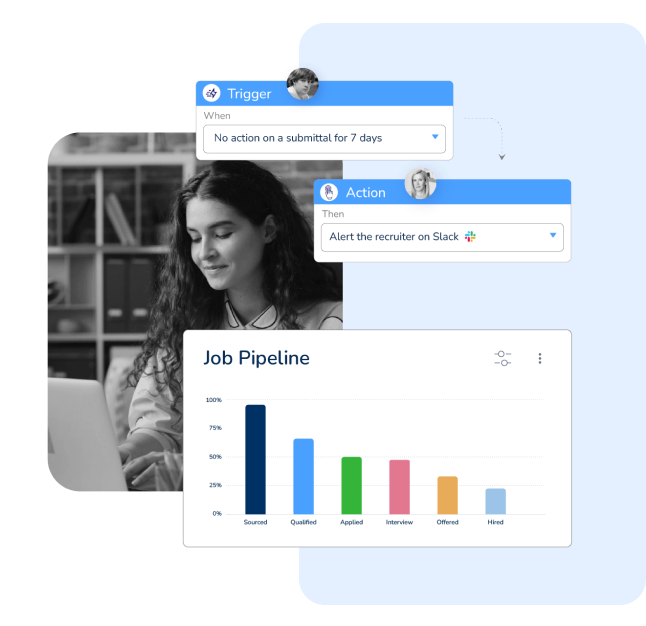
It’s an AI-first command center that helps you manage all your agency’s recruitment operations. It’s the only software your agency needs to optimize all its recruitment operations:
- Integrated ATS & CRM
- Centralized candidate database
- Top-notch recruiting automation
- Multi-channel outreach (Email, SMS, Call & Socials)
- AI-first screening and sourcing tools
- Data enrichment capabilities
- Advanced reporting and analytics
- Open APIs and a host of integrations
Scott S., a Recruitment Specialist, reviewed us on G2Crowd:
“I’ve been using Recruiterflow, and it’s been a game-changer for streamlining my recruitment process. The automation tools for campaigns to candidates, LinkedIn, email integration, and customizable pipelines make managing candidates and clients so much easier. I love how it cuts down on manual work, letting me focus on building relationships instead of chasing admin tasks.”
See it in action now: Book a free demo
Recruitment


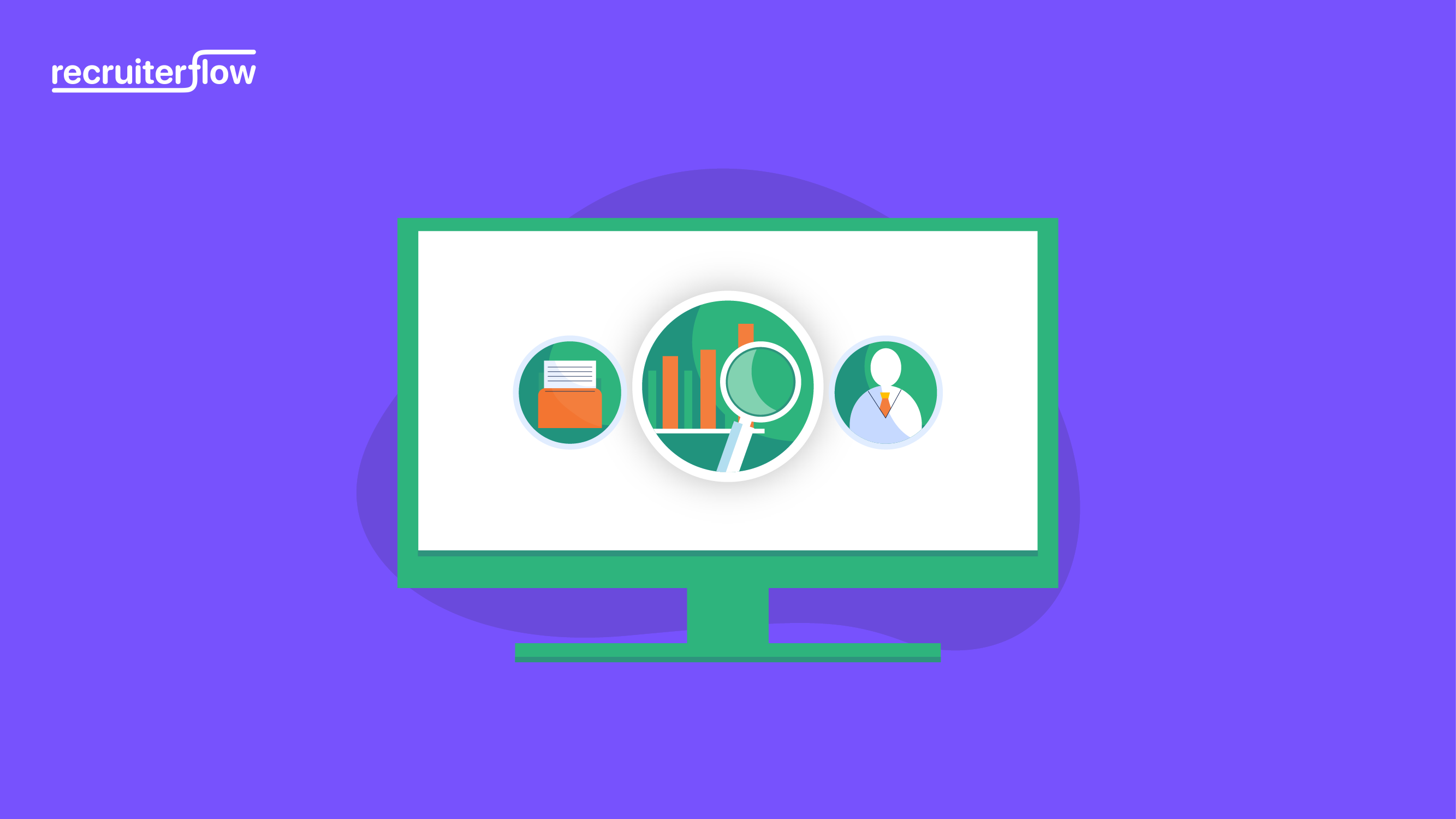
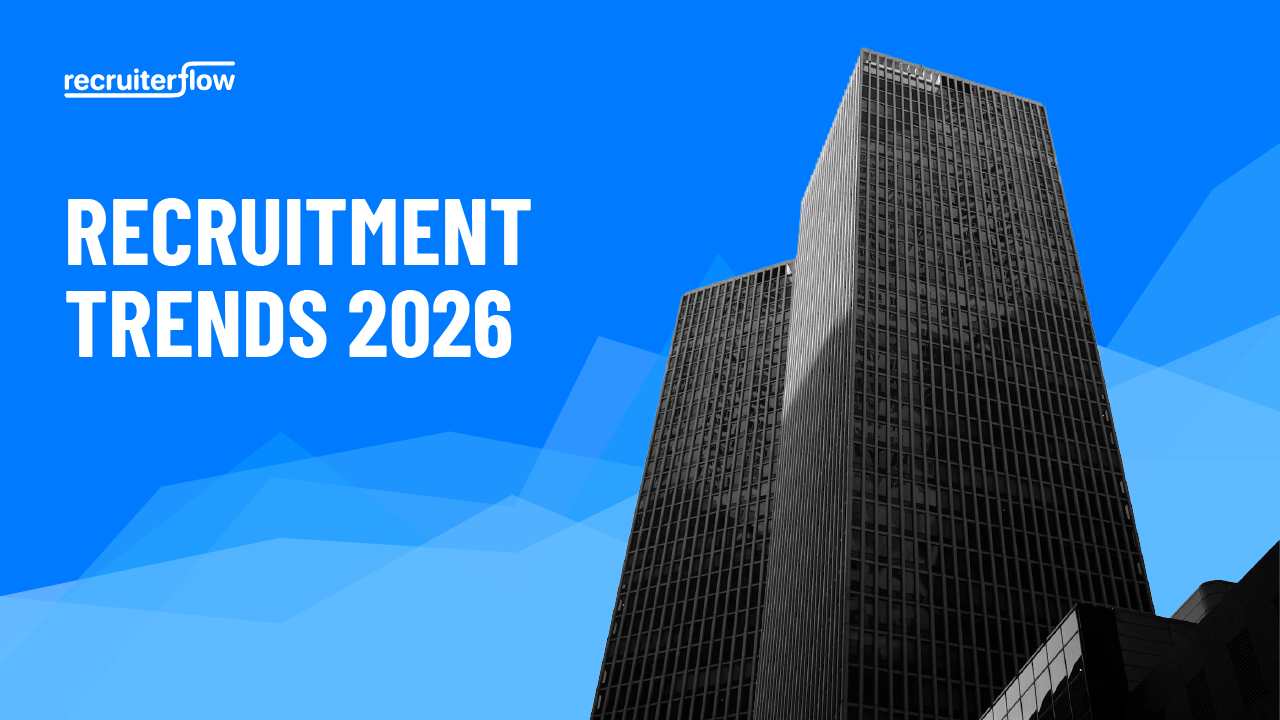

Pragadeesh Natarajan